Group CEO, Arada HOW
MORE ATTENTION/ As per Gary Vaynerchuk P.17 CHALLENGING NORMS/ WakeCap founder Dr. Hassan Albalawi P.47
THE 10 TYPES OF
Spot your type P.37

Group CEO, Arada HOW
MORE ATTENTION/ As per Gary Vaynerchuk P.17 CHALLENGING NORMS/ WakeCap founder Dr. Hassan Albalawi P.47
THE 10 TYPES OF
Spot your type P.37

BUILT ON SEVEN YEARS OF EXPONENTIAL GROWTH, THE UAE MASTER DEVELOPER DETAILS ITS GLOBAL AGENDA P.22

Bringing luxury seaside living to Sharjah for the first time, owners at the Anantara Sharjah Residences enjoy access to the Anantara Sharjah Resort’s world-class amenities, including an infinity pool, five distinctive restaurants, an Anantara Spa and a state-of-the-art gym. As an investment, owners can enjoy the benefits of a rental management scheme operated by Anantara Hotels, Resorts & Spas, allowing them to maximize their returns when they are not resident in the property.
To register your interest, visit arada.com
LIFE IS A JOURNEY.
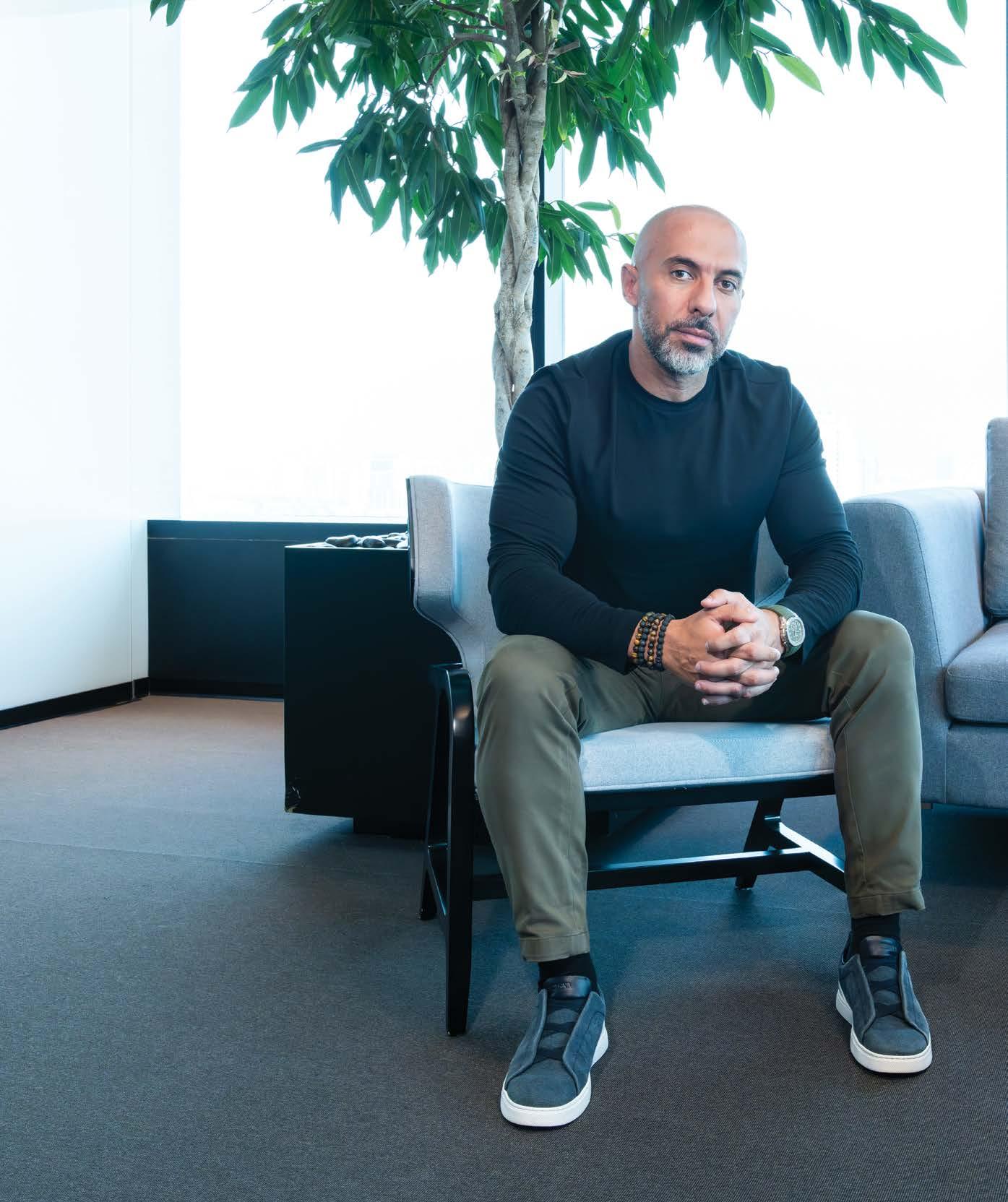

Nestled by the coast of Lusail sits the splendor of Raf es and Fairmont Doha, where luxury is rooted in even the smallest details. Open the doors to mesmerizing hospitality and make memories in a world of sophistication.



Step into a world of opulence when you book a Suite at Raffles Doha.
Experience the added luxury of QAR 750 credit to spend on dining in the hotel, and QAR 500 towards any Spa treatment.
Children aged 12 and below are welcome to indulge in the enchantment of complimentary dining.
Rates starting from QAR 3,500 per night
For reservations, please call +974 4030 7100 or email reservations.doha@raffles.com







DataPatrol is a cutting-edge information and data security company specializing in advancing the data security journey and addressing existing gaps with innovative solutions. With years of experience in data security, we specialize in mitigating insider threats and safeguarding sensitive information.
A full set of features to prevent internal data breaches OUR SOLUTIONS ARE:
DataPatrol provides companies with a comprehensive, innovative, and user-friendly full set of features, to secure sensitive and confidential data from unauthorized disclosure.
Easy to use
Seamless Setup and integration
Fully Customizable MultiOS
Android-Ready (Android Oreo and above)

An internal breach can have devastating consequences on your organization, far beyond the immediate financial loss. When sensitive data is compromised from within, it can erode trust with clients and partners, damage your brand's reputation, and lead to costly legal repercussions.
With the continued rise of insider threats, organizations need to implement robust internal security measures and fill in the gaps in their data protection protocols.

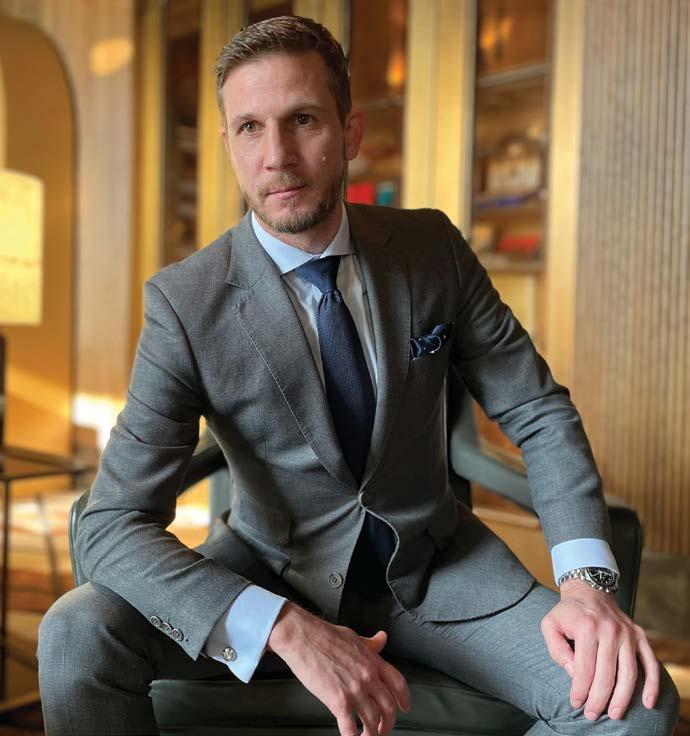
17 How to Get More Attention
You can’t run a great business if you can’t capture people’s attention, says GARY VAYNERCHUK.
20 “Be the Change” Might Need a Change
ATTELINE’S DUSHANE SOLOMON believes a rethink is necessary in how we go about global pleas for a more sustainable future.
↑ Wingman Executive founder Paul Littlejohn was featured in the second episode of Entrepreneur TV Middle East’s Paradigm podcast series. P.54
47 Challenging Norms
WAKECAP founder and CEO DR. HASSAN ALBALAWI is building a business centered on improving workforce productivity in the construction industry.
58 “We Got Funded!”
The stories behind the recent fundraising successes seen by MENA-based startups KEYPER and MYSAFE.
37 The 10 Types of Workaholics
ANDY BROWN explains how to spot your type, understand what’s driving you, and what to do about it.
44 Beyond the Basics
YOLK BRANDS founder and CEO
STEVE FLAWITH shares six branding lessons no one will teach you.
52 The Road to Successful Exits in Saudi Arabia
IMPACT46 Managing Partner
BASMAH AL SINAIDI shares lessons from the venture capital firm’s investment strategy.
56 Driving Growth
MICHAL SOBIERAJ makes the case for why your company needs a fractional CFO.
EDITOR IN CHIEF Aby Sam Thomas aby@bncpublishing.net
CEO Wissam Younane wissam@bncpublishing.net
MANAGING DIRECTOR Rabih Najm rabih@bncpublishing.net
ART DIRECTOR Simona El Khoury
MANAGING EDITOR Tamara Pupic tamara@bncpublishing.net
FEATURES WRITER Aalia Mehreen Ahmed aalia@bncpublishing.net
DIGITAL SOLUTIONS DIRECTOR Mahdi Hashemi mahdi@bncpublishing.net
DIRECTOR OF INNOVATION Sarah Saddouk sarah@bncpublishing.net
GROUP SALES DIRECTOR – B2B GROUP Joaquim D’Costa jo@bncpublishing.net
COLUMNIST Tamara Clarke
CONTRIBUTING WRITERS
Basmah Al Sinaidi, Andy Brown, Fida Chaaban, Steve Flawith, Scott Gilbey, Brittany Hunt, Nicole Lapin, Dushane Solomon, Mina Vucic
SUBSCRIBE
Contact subscriptions@bncpublishing.net to receive Entrepreneur Middle East every issue
COMMERCIAL ENQUIRIES sales@bncpublishing.net ENTREPRENEUR.COM
Access fresh content daily on our website
Immerse yourself in unparalleled luxury at Dusit Thani Abu Dhabi. Enjoy up to 10% off on room rates and indulge in the ultimate pampering with a 20% hotel credit for dining and spa experiences during your stay. For reservations and inquiries, contact +971 2 698 8888 or email reservations.abudhabi@dusit.com

Booking Period: Till 10 June 2024 | Stay Period: Till 10 July 2024 Scan the code to book directly
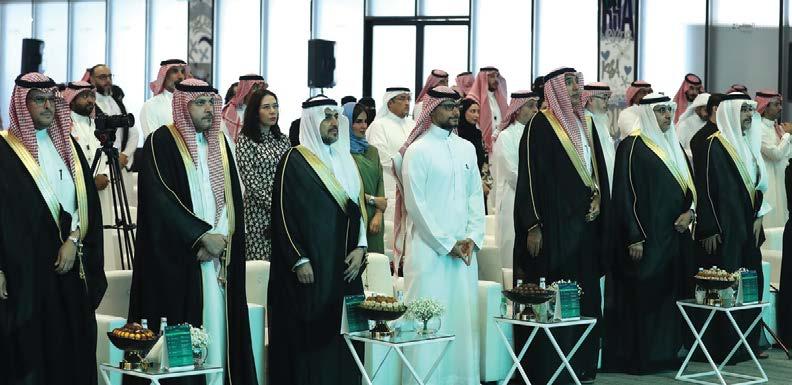
Hundreds of foodtech stakeholders from across Saudi Arabia and the GCC come together for Red Sea FoodTech Connect 2024
The third edition of Red Sea Foodtech Connect, an annual Saudi Arabia-based conference for foodtech startups, entrepreneurs, and stakeholders, which was held in Riyadh on June 11, 2024, saw the convening of major decision-makers, innovators, and investors from across the foodtech ecosystem in the Kingdom and the wider region. This edition of the annual event was hosted by the Sunbolah Program, an initiative of the KSA Ministry of Environment, Water, and Agriculture (MEWA), and sponsored by Jahez, Saudi Arabia’s online food-delivery unicorn. Red Sea Foodtech Connect founder Mohammed AlQurashi shared that the 2024 edition of the annual event saw hundreds of attendees from the UAE, Bahrain, Kuwait, Egypt, Jordan, Australia, and France, among many others. The Sunbolah Program’s main representatives at the conference were H.E. Mansour Mushaiti, Vice Minister, MEWA, Dr. Ali Alsabhan, General Manager of Entrepreneurship, MEWA, as well as other members of the Ministry.
Held under the theme “Meet The Big,” this year’s edition of Red Sea Foodtech Connect saw the participation of a number of key entities from the sector including the National Center for Palms and Dates (NCPD), an organization that aims to develop KSA’s dates sector through improving production efficiency and quality, Nadec, a Riyadh-based F&B company, Calo, a Bahrain-based app that provides nutritious meals for busy people, and the Saudi Agricultural and Livestock Investment Company (SALIC), a KSA joint-stock company owned by the country’s sovereign wealth fund, Public Investment Fund (PIF).
This year’s conference held a plethora of discussions and talks by national and regional industry experts headlined by HRH Prince Khaled bin Alwaleed bin Talal Al Saud, founder and CEO of KBW Ventures. During the fireside chat titled “Venture Capital View,” and moderated by Abdulrahman AlJiffry, Partner at KSA-based venture capital (VC) fund 500 Global, Prince Khaled shared how he has made investments across multiple technology sectors, his insights on growth stage-financing, and how he has adopted a first-mover approach in backing startups in the foodtech and

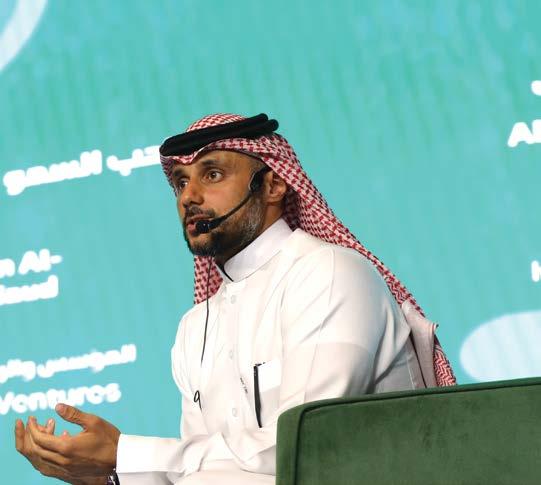
alternative proteins sectors. “Saudi is smart money; we know what we’re doing,” said Prince Khaled during the session “So, while we have people coming from all over, success here isn’t free. You need to invest as well, you need to have skin in the game, in our ecosystem, if you want to succeed.”
Other key speakers at the event included Dr. Mohammed Alnuwairan, CEO, NCPD, Dr. Sulaiman Altwaijri CEO, Nadec Food, Samer Alsourani, SVP, SALIC, and Dr. Mazen Alzaidi, General Partner, STV, a Saudi-based technology VC fund. MEWA’s Dr. Alsabhan and Mushaiti also offered talks at Red Sea Foodtech Connect that respectively highlighted the Sunbolah Program’s impact on the food value chain, as well as the significance of fostering innovation in the foodtech economy. redseafoodtech.com








| AUGUST 30TH
FOR EDITORIALS
VIBHA MEHTA +971 58 6314145 vibha@bncpublishing.net
FOR SPONSORSHIP OPPORTUNITIES
JOAQUIM D’COSTA +971 50 440 2706 jo@bncpublishing.net
ALEX BROWN +971 56 308 2946 alex@bncpublishing.net
SARAH SADDOUK +971 55 536 7011 sarah@bncpublishing.net

G
You can’t run a great business if you can’t capture people’s attention, says Gary Vaynerchuk. And today, that requires getting very creative. by NICOLE LAPIN
b

Everyone wants attention. Few of us know how to get it.
Why? According to attention-getting master Gary Vaynerchuk, it’s because most people misunderstand where attention comes from—and that the means of getting it keep changing.
“Social media was once more like email marketing,” he says. “You would get as many people to follow you as possible, and when you would post, a percentage of them would see it. Today, one of your clips on TikTok can get 10 million [views], and another might get 4,000. The distribution now happens with algorithms, and that is a massive land grab that I want people to know about.”
Vaynerchuk has built a massive social following, and a constellation of successful businesses under his company VaynerX, by understanding how the means of attention keep shifting. His new book, Day Trading Attention: How to Actually Build Brand and Sales in the New Social Media World, is a guide to understanding attention—and how to spot and exploit “undervalued” opportunities. Here, he explains how to do that, why he’s not afraid of AI, and why attention will never be in short supply.
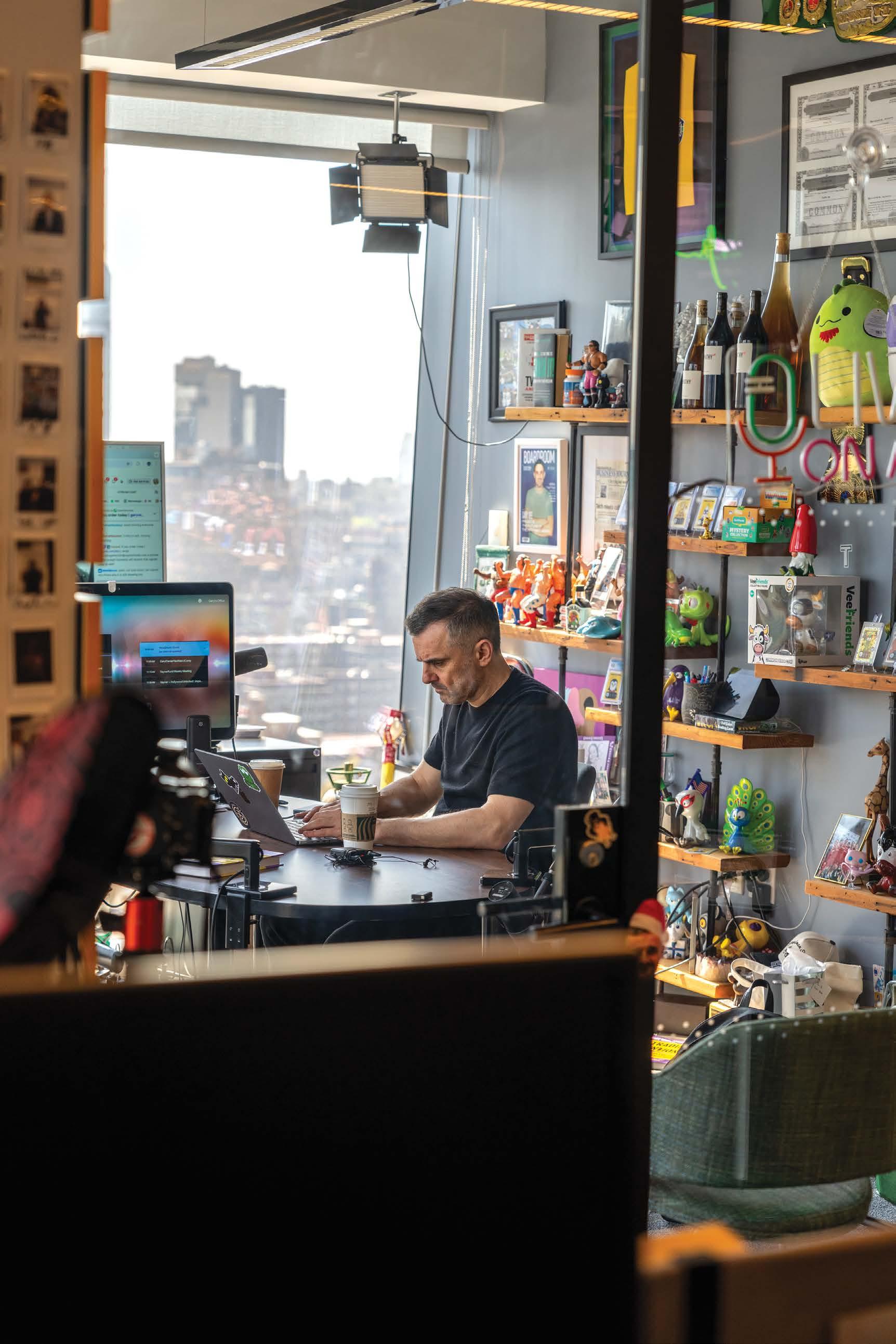
Are you using AI tools for your own content yet?
We’ve been slow to, and that’s because of the terms of service.
A lot of these AI companies were very spooky to me, because if we ingested our content, it wasn’t clear if they could use it.
I have unlimited content on the internet, so I know that anyone can take it, ingest it into an AI tool, and think or act like me. But it’s one thing if someone went on the internet and took my stuff. If I self-deposit my content into an AI tool, I want to know what’s going w
to happen. Now it seems like AI companies are starting to write terms of services where they say, “You can use our tool, but we have no rights to your information.”
So what is scaring you with AI? Nothing scares me per se, but the thing that everybody should always be vigilant on is: What don’t we know? I am not overtly scared of the robots killing our children, but I don’t eliminate it as a possibility.
Anything can happen. I just don’t demonize new technologies. I look at the optimism. I don’t think about all the jobs that AI is going to take out; I think about all the jobs that AI is going to create. When the tractor was invented, the number of people who worked on farms in this country was insane. It put many of them out of work. You know what that meant? People went on to do more profound things. The jobs we’ll lose because of AI in the next decade will be replaced. For example, this will be a massive job: prompt engineer. Being good at asking AI questions is a skillset. So for every kid that’s like, “Oh, my God, I can’t be an Adobe designer anymore”—well, first of all, I’m old enough to know when that wasn’t a job. Adobe replaced the people who used to design on paper. People forget that the world has worked this way forever.
Do you worry that AI will replace the work you do at your ad agency, VaynerMedia? I’ll put myself out of business before I let someone else do it— meaning, I will adjust to the reality of the game. We’ve built one of the largest global independent agencies in the world by taking money directly away from the Don Drapers of the world. Every dollar that VaynerMedia has is a dollar that older, larger agencies had. So if I’m taking from some-
one else, I can’t be a hypocrite. I don’t think that I am entitled to benefit from entrepreneurship. I think I need to respect entrepreneurship, and be a good entrepreneur, and then I will reap the benefits of it. This is my biggest problem with fake entrepreneurs that make a lot of money, and then go use their money in politics to try to change laws to keep their money. I don’t respect that, because I think they’re losers. If AI is destined to come and kill me, then I will Obi-Wan Kenobi that shit.
In your book, you describe attention-getting tools as either undervalued, where there’s an opportunity to get in early and establish yourself, or overvalued, where it’s crowded and more expensive and difficult to stand out. TikTok might seem to be overvalued, because it’s so crowded—but that doesn’t mean it’s too late for someone to start posting there, right?
four years. A stay-at-home mom or dad is going to stream their morning of cooking, cleaning, and getting the family ready, or mowing their massive lawn, and that person will go on to make seven figures.
Don’t forget—when Twitter was new in 2006, everyone was saying, “This is so stupid. Who cares if you’re having a pizza? Who cares that you’re walking your dog?” And my answer back then was: Everyone. It’s how human communication works.
I struggle with this. Because as a business owner, I think, “I’m running a business, and I’m already supposed to be on social all the time. Now I should be streaming all the time?”
Well, that’s why I suck at streaming right now. I’m streaming my office right now—but my problem is, my day-to-day is so boring. I’m literally sitting at my desk doing 12 straight hours of meetings, and the entire stream
to bring awareness of what I’m doing, that’s ROI positive. Also, I love a twofer. For example, I do podcasts for two reasons: One, it brings me the attention of that podcast’s audience. But two, I’m also filming it, because I need the content! My life is my production facility.
You’re launching a new book, which reminds me of great advice that you gave me when I launched a book: You said to go off the grid for two weeks, write a list of everyone I know, and then contact them.
I still give that advice! Asking is okay—so long as you don’t judge them if they don’t deliver. People struggle with this, because their feelings get hurt when someone doesn’t buy a bunch.
I DON’T THINK THAT I AM ENTITLED TO BENEFIT FROM ENTREPRENEURSHIP. I THINK I NEED TO RESPECT ENTREPRENEURSHIP, AND BE A GOOD ENTREPRENEUR, AND THEN I WILL REAP THE BENEFITS OF IT.”
Correct. It would be like saying, “There’s no room for Billie Eilish because Madonna and Cyndi Lauper and Whitney Houston were pop stars, and all the pop star opportunities are done.” It’s a merit-based game. Every platform is fertile ground—but especially once one gets overpopulated, you need creativity to be the best.
So what’s something very undervalued right now? Live streaming the mundane. There’s going to be a big movement of that in the next three to
is on mute because the meetings have sensitive information.
But there are ways to be clever. Years ago, when I decided that I wanted to vlog, I was like, I can’t do that. But then I took a crazy step and hired [my former videographer] D Rock, who literally started following me around with a camera.
But how do you run a business when you’re doing content all the time?
Listen, I am very busy—but if I can allocate 30 or 40 minutes
The most impactful story I have on this is: I helped someone get an eight-figure exit on an investment, and then asked him to buy copies of my book... and he ghosted me. I asked four times! I was baffled. But I also remember being excited, because I was able to call my bluff on myself. I’ve continued to have a relationship with that person, because my brain goes to, “Maybe he was busy. Maybe he was in a bad place. I don’t know. Who am I to judge?” Here’s the key: I was asking— and when you ask, you’re not allowed to judge.
To hear more of the conversation, listen to Nicole Lapin’s podcast, Money Rehab.

A rethink is necessary in how we go about global pleas for a more sustainable future by DUSHANE SOLOMON
Be the change that you wish to see in the world” is a quote with origins that trace back to 1913. While my origins aren’t nearly as old, I’ve always believed—despite having once viewed our world like Louis Armstrong (as wonderful)—that this quote was more idealistic than realistic. ChatGPT agrees with me—it says: “This quote is flawed, because individual efforts alone are insufficient to address systemic issues that require collective action and structural change.”
}Why so pessimistic?
I was born in Canada but raised in a Tamil household where, thanks to my parents, my sustainable mandates unintentionally became running water at a trickle since “money didn’t grow on trees,” and clearing my plate because “kids were starving in Africa.”
Lifestyle creep makes it harder to abide by these teachings; my plastic water bottle usage
and Deliveroo mileage exemplify this, but I blame Statista for proving my adolescent efforts were futile: indeed, the prevalence of undernourishment in Africa in 2008 was 19.5%, and as of 2022, it worsened to 19.7%. But like an iceberg is just 10% visible above water, I have intentionally painted only part of the picture. In reality, Africa’s underfed population in 2008 and 2022 represent significant progress from 2000 (24.1%). As a
child, if I knew data could be manipulated this easily, avoiding my veggies may have been easier.
Maybe my parents’ mindset did help hungry kids in Africa, but without transparent metrics to measure how my diet impacted starving children globally, I’ll never know. Similarly, I don’t know how we produce more than enough food to feed 1.5 times the global population—but up to 783 million people suffer from chronic hunger.
That’s about 10% of all the people on our planet—but carbon emission reductions seemingly remain the priority.
}As a copywriter at UAE-based communications agency Atteline, I know that research supports my content, much like a comedian’s timing does the perfect punchline, and I accordingly leverage statistics to help elevate my clients’ brands. However, I doubt the sustainability data I’ve come across will elevate your spirit— since it unfortunately disheartened mine.
I was initially optimistic about Atteline’s journey to achieve B-Corp certification (something only seven UAE businesses out of 6,700 globally have attained), but my optimism has since wavered. You see, the United Nations Sustainable Development Goals (SDGs) were created in 2015, and as of 2023, only 15% of these SDGs were on track, 48% were off track, and 37% were stagnating or regressing. Simply put, the United Nations’ progress on SDGs is lackluster—but who does the onus fall on?
I assume it’s the “key stakeholders,” the ones who have frequent conversations about creating a more sustainable world—yet, somehow,
more than 700 million people are still living below the poverty line. From where I’m typing, it feels like global pleas for a more sustainable future are often veiled behind financial incentives rather than genuine humane intentions.
}In essence, I feel like B-Corp certification won’t make a dent in the grand scheme of things when our priorities, as citizens of the world, don’t seem to be in order.
Maybe it’s because Amazon
this shift- while negatively contributing to SDG 12: Responsible Consumption and Production.
Maybe it’s because I can write this piece from my iPhone while wearing Air Jordans, knowing both Apple and Nike have been under fire for using sweatshops and child labor—and I, myself, am negatively contributing to SDG1: No Poverty.
Perhaps that’s it—we talk the talk, but don’t walk the walk.
As a semi-conflicted Sustainability Ambassador at
mented a carbon tax to decrease fossil fuel use and adopt greener forms of energy while locally, initiatives like UAE Net Zero 2050 have been issued by the government to achieve similar targets.
}On the surface, these directives seem great. However, if the proverb “It takes a village to raise a child” holds any weight, then, the sentiment that our actions today are for tomorrow’s children is not being sufficiently upheld.
THE UNITED NATIONS SUSTAINABLE DEVELOPMENT GOALS (SDGS) WERE CREATED IN 2015, AND AS OF 2023, ONLY 15% OF THESE SDGS WERE ON TRACK, 48% WERE OFF TRACK, AND 37% WERE STAGNATING OR REGRESSING.
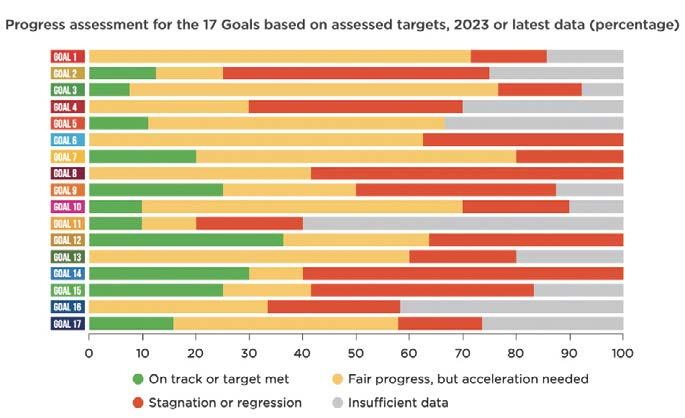
proudly highlights sustainable achievements online, but downplays its workplace safety concerns claiming there’s no regulatory metric called “serious injury rate” —and thus, it couldn’t possibly contribute negatively to SDG3: Good Health and Well-Being.
Maybe it’s because we, as humans, consume 400% more clothing than 20 years ago, and fast fashion brands like Shein are at the forefront of
Atteline, how can I convince my colleagues that their sustainable efforts could be impactful if I don’t feel like my concern is sufficient? After all, I’m not a multi-billion conglomerate with the financial means to make a true impact—or like a greenwashing company that refuses accountability for its actions, that’s the excuse I recycle Truthfully though, I’m aware action is being taken. For example, Canada has imple-
Because sustainability is about more than the environment, it’s about the people living in it—or with what’s happening across the water, the people struggling to live in it.
My parents were victims of genocide, fleeing a war-torn Sri Lanka decades ago to prevent me from having to deal with the same hardships, including perpetually living life in fear of death. Being far removed from my culture, I can’t comprehend what their struggle truly entailed, but I can empathize with the current situation of the Palestinians.
Unfortunately, I feel like nothing I do will change their fate despite the collective effort I see from my Instagram network. Why would I think my efforts could make a difference, if “key stakeholders” seem more focused on reducing our carbon footprint, than halting the violence that has taken, and continues to
take, the lives of tens of thousands of human beings?
While human footprints seem to be less important than our carbon ones, I’m still working to reduce my use of plastic water bottles. However, this effort is inherently selfish by nature, since it benefits my physical and financial health—but then again, maybe it’ll help reduce the 14 million tons of plastic that find its way into the ocean every year.
As I do this, I’m trying to remember that achieving sustainability is like working out. The first few days of getting back into the gym are a drag, and the first couple of weeks are discouraging when progress is slow, but I’ll try and stick with it since I’m privileged to. Similarly, through my sustainability efforts, I’ll hopefully inspire others to be responsible citizens of the world.
Until then, I maintain my initial sentiment: working to “be the change we want to see the world” is irrelevant, because we (as citizens in society) aren’t enacting our citizenship strongly enough to create the change we need for equity, let alone the preservation of not only our natural resources but of our society as a whole—despite today’s headlines suggesting the opposite.
With that said, I’ll be the change I wish to see for myself—because if I don’t, I’d be just as hypocritical as those “key stakeholders.”

Dushane Solomon is a copywriter and a Sustainability Ambassador at Atteline, an award-winning public relations agency headquartered in Dubai, UAE. atteline.com

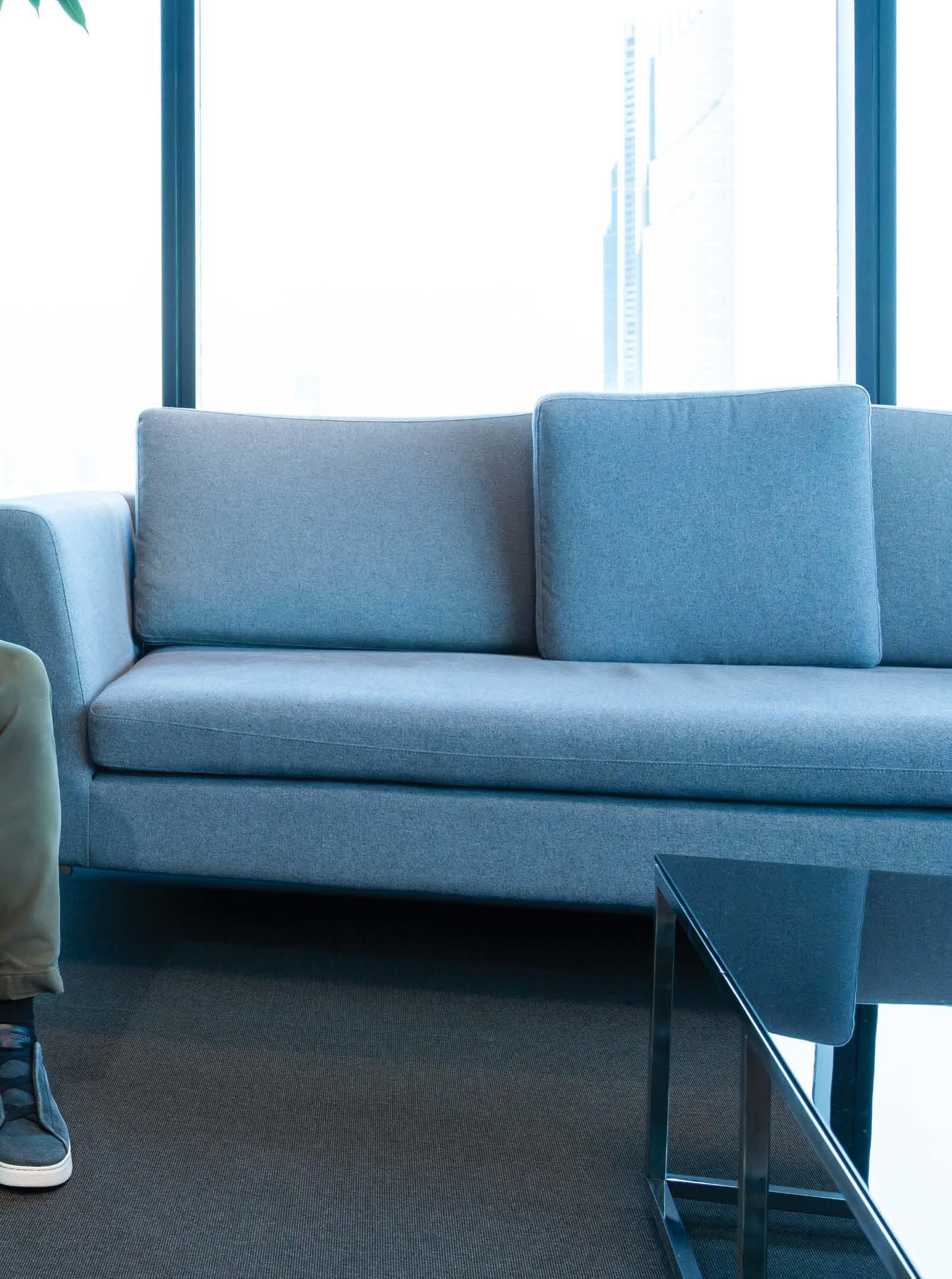
Ahmed Alkhoshaibi Group CEO, Arada
Building on seven years of Arada Group’s exponential growth, its Group CEO AHMED ALKHOSHAIBI details the UAE master developer’s global agenda.
We’ve never been a short-term company–that’s the secret to our success,” says Ahmed Alkhoshaibi.
The founding Group Chief Executive of Arada, an affable Australian national who leads what is now one of the UAE’s largest master developers, is sitting comfortably in an office whose walls are covered with architectural plans and renders, with 3D scale models on every desk and surface.
On one side of the office, the view stretches away over the runways of Dubai’s airport to the distant towers of Sharjah, where Arada first began its operations. And on the other side, there’s an even more impressive view over the elbow of Dubai Creek, with the Sheikh Zayed Road skyline looming on the horizon. When questioned as to whether these two views reflect the company’s past and future, Alkhoshaibi smiles.
“Arada was born in Sharjah, but we’ve always been a UAE company. We wanted to focus on Sharjah and transform the market there, but it was never our plan just to stay in one Emirate. Before Arada came, there was a certain perception of the Sharjah market, that there was more demand for affordability rather than quality, but the fact that we are selling villas for AED10 million in Sharjah proves that there is definitely a premium there. And having transformed that market, it was time to go to Dubai.”
During the course of this rare sit-down interview, the conversation drifts over a wide range of topics, including the ethos behind community creation, trees –undeniably one of Alkhoshaibi’s favourite subjects– the importance of retaining a startup mentality, and, of course, expansion and the future.
Arada has certainly grown exponentially in the seven years since the company was founded. From small beginnings with the launch of the Nasma Residences villa community in early 2017, Arada now oversees a project portfolio valued at over AED60 billion, including Sharjah’s largest ever mixed-used community, Aljada, the UAE’s first forested development, Masaar, and the ultraluxury Armani Beach Residences at Palm Jumeirah in Dubai.
(with another 21,000 in the pipeline), has a workforce of over 1,000, and is the youngest private company in the UAE to have obtained ratings, and completed successful issuances on the global bond markets (via a debut US$500 million sukuk in 2022, and more recently a $400 million deal in June this year).
↓
Arada has now completed over 9,000 homes
All this has been shepherded since inception by Alkhoshaibi, under the watchful eye of the company’s Chairman and Vice Chairman, Sharjah’s Sheikh Sultan bin Ahmed Al Qasimi and Saudi Arabia’s Prince Khaled bin Alwaleed bin Talal, respectively. Not bad for a company that started out with little more than a core team of just 12 professionals as well as a highly entrepreneurial mindset. So, what’s really been the secret to Arada’s rapid growth? Alkhoshaibi is unequivocal.

WILL BE
WITH SHORT-TERM THINKING IN A BOOM MARKET, AS PEOPLE WILL BUY ANYTHING. BUT OUR LONG-TERM STRATEGY DOES CONVERT TO FINANCIAL SENSE PRETTY QUICKLY.”
“We had a vision that was clear from day one,” he points out. “We believe that when people and spaces connect, great things happen, and we create spaces that allow people to enjoy happier, healthier, and more meaningful lives. That’s our compass, so when we design our communities, we have principles we follow to make sure we stay true to our purpose.”
Perhaps the most notable principle, which is immediately obvious when entering any Arada community, is the landscaping. At least 50% of every master-planned development delivered by the company is made up of open space, the majority of which is covered by dense greenery, including trees and shrubs. The most famous example of this is Masaar, the UAE’s first “forested” community, which includes a “green spine” of 70,000 trees, part of which has already been completed.
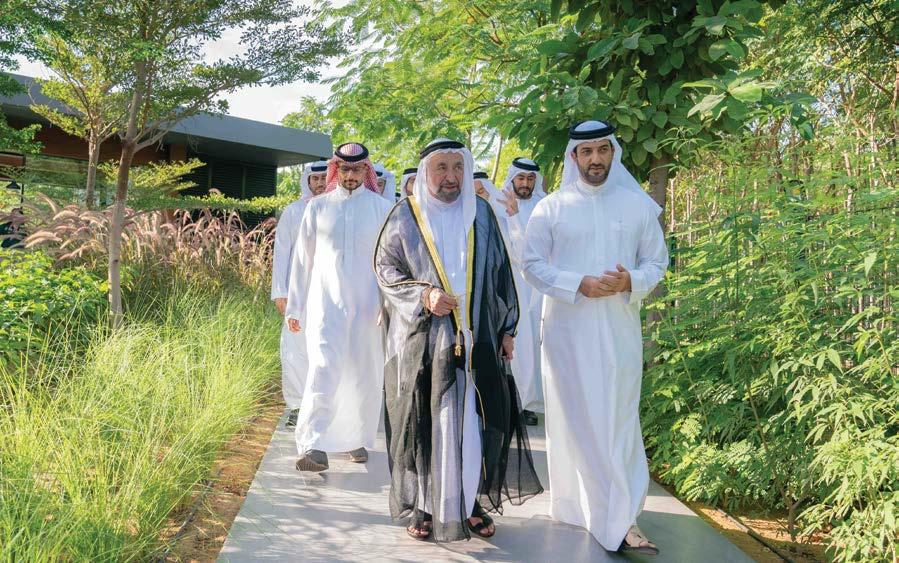
the inclusion of luminaries such as Japan’s Tadao Ando and Zaha Hadid Architects in the design of its projects–not to mention the 40 in-house architects Arada employs in its design department.
“We always give hierarchy to nature,” Alkhoshaibi says. “So, we design the nature aspect first, the tree lines and so on, and then we do the infrastructure and the buildings. Other developers will do infrastructure and the buildings first, and then give over whatever is left for trees and plants, but we prioritize our trees.”
“Keeping that open space level at 50% is in itself discipline,” he continues. “You have the finance department saying that we need to make more money and squeeze in more homes, but that’s what I mean by short-term thinking. We invest in open space, and we activate that space, allowing people to walk more, play more sports, and be more social. A great example of that is the park at Nasma Residences, which is over half a million square feet in size. It’s one of the nicest parks in Sharjah, it’s always full, and this was done by a private developer using its own budget–this is just one of the ways we can support the government.”
However, the landscaping is just one of the Arada principles of community building. Others include the need for great architecture and design, as evidenced by
Another feature is the importance of world-class facilities, whether it’s the many schools, hotels, office buildings, shops, restaurants, and sports amenities that help to make up the colossal Aljada master plan, or the AED100 million invested to create a continuous looped professional woodland cycling circuit in Masaar. Most of these amenities are available to residents and visitors even before the first homes have been completed, helping to create a destination, encouraging people to get outside, and adding value to the project at the earliest possible point.
Other key considerations include careful stewardship of the local environment. Alkhoshaibi says that all landscaping at Arada communities is fed by treated wastewater from onsite plants, and all homes contain extensive smart features, as well as Arada Care, the division set up specifically to look after owners and residents after the sales process has been completed. The company has also made waves globally with its Home for a Home campaign–a first-of-its-kind initiative that has seen Arada donate homes for vulnerable families in Kenya and Syria for every home sold in its communities during Ramadan over the last three years.
“This approach comes from our founders–it’s in their DNA,” says Alkhoshaibi. “They put people first, and }}

“
they are extremely active and healthy. This ethos has to come from the top; I have similar values myself, and that’s how we came up with these principles. In fact, it’s not just corporate strategy, it’s something we live by. That’s one of the core reasons for our growth.”
“Developers will be fine with short-term thinking in a boom market, as people will buy anything,” he continues. “But our long-term strategy does convert to financial sense pretty quickly. Investing in the public realm does cost money, but it beautifies the area, and the asset appreciates. At Aljada in our first phase, we were selling at AED700 per square foot, and now, we’re at AED1,300. Why? Because people want to live in Aljada. And it’s not because of the homes, nice as they are–it’s because of the community. And that’s why I predict you’ll see that figure double to AED2,600 over the next five years.”
This long-term thinking has clearly paid off, with sales jumping steadily year on year, culminating with a 100% growth in the total value of property sold in 2023 compared to 2022, to AED7 billion, boosted by Arada’s entry into Dubai via the Jouri Hills at Jumeirah Golf Estates community, and the ultra-luxury tie-up with Armani on the Palm Jumeirah. Two more Dubai projects are imminent, the Group CEO adds, indicating that both will again target the luxury market and will be based in Dubai Harbour and Dubai International Financial Centre, respectively.
But a key plank of Arada’s approach has also been to diversify its revenue streams, both in terms of recurring revenue through verticals such as retail leasing, which has benefited from the ever-increasing number of shops and F&B outlets, which saw over five million visits last year alone. The firm is
WE BELIEVE THAT WHEN PEOPLE AND SPACES CONNECT, GREAT THINGS HAPPEN, AND WE CREATE SPACES THAT ALLOW PEOPLE TO ENJOY HAPPIER, HEALTHIER, AND MORE MEANINGFUL LIVES.”
also concentrating on education, with one K-12 international school open and two more on the drawing board, and it has additionally launched a series of complementary brands.
These include Wellfit, now the UAE’s fastest growing fitness brand, with three large-scale fitness centres in Jumeirah Village Circle, Meydan, and Aljada, and new venues on the way in more locations across the UAE and beyond. In the process, Wellfit has become a money-spinner in its own right, with over 14,000 memberships won so far, and some estimates suggesting the company is on track to reach a valuation of up to AED1 billion over the next seven years.
“These are incredible spaces that not only feature state-ofthe-art equipment, but have plenty to do for the kids,” Alkhoshaibi says. “It’s one of the brands that really helps our destinations–you put a Wellfit in, and it activates the space.”
THE TEAM THAT WE’RE BUILDING, THE IDEAS THAT WE’RE CREATING, AND THE SYSTEMS THAT WE’RE IMPLEMENTING CAN BENEFIT NOT JUST THE UAE, BUT ALMOST ANY COUNTRY AROUND THE WORLD.”
Alongside Wellfit, Arada has also launched Manbat, a social impact partnership with the UAE Ministry of Climate Change and Environment that focuses on connecting Emirati farmers with local consumers; Zad, a food truck park; Hungry Wolves, a healthy eating brand; Artal, an Emirati fashion store; and Yalla, an e-mobility solution for the company’s communities. In addition, Arada signed its first master franchise agreement with Boost Juice, a popular brand from Alkhoshaibi’s native Australia, which now has six branches already open across Dubai, Sharjah, and Abu Dhabi, with another 20 to follow.
In addition, Arada has also recently announced the creation of a new hospitality and entertainment division, headed by industry veteran Amit Arora, whose mandate is to ensure that 20% of the company’s revenues derive from this division in five years’ time. As for geographical expansion, Alkhoshaibi says he has always been clear about Arada’s strategic direction.
“There was always a plan to launch in Sharjah, establish a dominant position there, and then shift to Dubai. From Dubai, we’re looking to expand into Saudi Arabia, and from there, internationally–so, some of the markets we have mentioned previously include the UK, Italy, and Australia. We don’t rush–we took a leadership position in Sharjah, where we now have about 50% of the off-plan market, and it took time for us to find the right locations to be able to launch in Dubai.”
But it’s also clear that the Group CEO feels that there are no limits

to how far Arada can go, given the structure and procedures he has put in place, hinting that international expansion may be on the cards even before the end of this year.
“The team that we’re building, the ideas that we’re creating, and the systems that we’re implementing can benefit not just the UAE, but almost any country around the world,” he concludes. “We don’t want to be known for just being successful in one Emirate or one country. You can apply our set of rules and principles everywhere, and that’s why we’re so confident.”
↓ As Group CEO of Arada, Ahmed Alkhoshaibi leads what is now one of the UAE’s largest master developers.
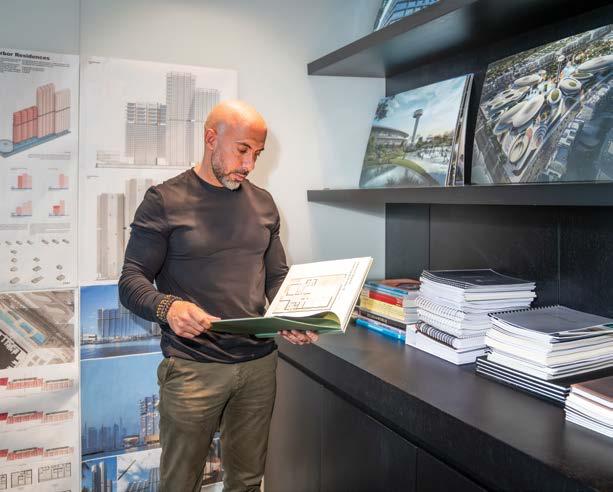
} 150,000
Number of trees in Arada’s nursery in Aljada, one of the largest of its type in the UAE
}50%
Arada’s share of the off-plan market in Sharjah
}346
Number of women working at Arada (over a third of the workforce)
}14,000
Number of homes sold by Arada since foundation
}AED35 billion
Total value of Aljada, Sharjah’s largest ever project
}5.3 million
Visitors to Aljada in 2023
That’s
by SCOTT GILBEY
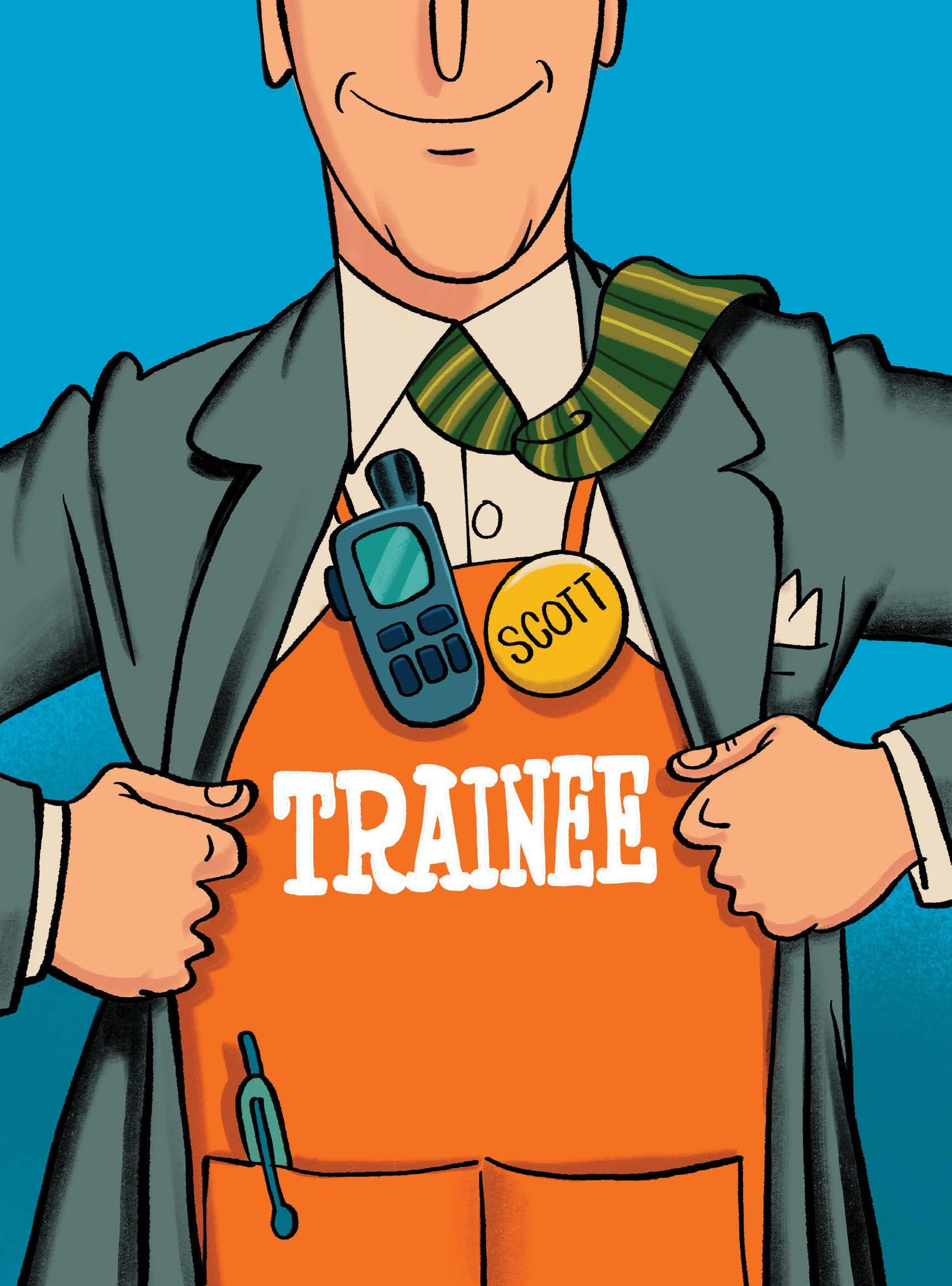

IFyou’ve ever worked a minimum wage job, you’ve surely watched a lot of training videos. Narrated training videos are a key component of Learning Management Systems, or LMS, and they’re how you learn your job.
I am now ashamed to admit this, but I made a lot of those videos. I spent years in the executive suite of an international company, working as a global senior vice president of customer experience, where I directed and produced many training videos. I thought they were smart and helpful. I assumed they increased efficiency.
And then I left my well-paying job and became a frontline worker making $16 an hour at a big-box retailer in Florida. I spent my first two weeks watching LMS videos, which trained me on the art of customer service and how my store functioned, and then I was thrust out into the store itself. That’s when I realized: Most of this stuff didn’t help me at all. The videos got me “lawyered up” with cautions and “branded up” with soothing marketing messages, but they left me incapable of doing anything useful on the job. All I kept hearing from customers was, Where’s my order? I need a refund! What do you mean you don’t know?
After 10 weeks, I decided to cut the phrase “In Training” from my name badge. It was starting to feel embarrassing. For how long could I possibly be in training? I showed this to my coworker Jim—a guy I had met while hunched over a shared laptop in the corner of a manager’s office, watching yet another LMS video together—but Jim laughed and said I was crazy.
“I’m staying ‘in training’ forever,” he told me. “That way, I don’t have to explain to customers why I don’t know what I’m doing.”
I have a lot of stories like this. Over a period of 30 months, I went on a “frontline immersion” by working at three retail brands across six different stores, plus an airline and a public school district. My goal was to see what I never saw as an executive—where customer experience breaks down, and why customers and employees become frustrated. It was emotionally difficult and often embarrassing. Yet I also came away hopeful. These problems aren’t unfixable. We really can make our customer experiences better, for businesses big and small.
But first, we need to see where it all starts to go wrong—on the frontline.
Ididn’t set out to be a customer experience (CX) executive. Instead, like many people, I started in the service industry. At age 17, I worked as a black-tie waiter/bartender and then on a cruise ship. This taught me a lot about how good experiences were profitable. The more food and drinks I sold, and the more pleased the customer, the more cash I took home. I never once met a dining customer who said, “Glad I didn’t eat or drink or dance.”
After a stint in engineering, I migrated into manufacturing sales, fascinated by how other managers worked, shadowing the best of them. One was a purchasing manager named Ron, from whom I ironically learned how to sell. I remember how he’d work:
RON: “What is your best price?”
BIDDER: “$590,000.”
RON: “Is that your best price?”
BIDDER: “OK, $570,000.”
RON: “Is that your best price?”
BIDDER: “Ron, you’re killing me. Will $530,000 get me the order?”
RON: “Is that your best price?”
BIDDER: “My boss is going to fire me. We have no margin left. $520,000.”
There were initially seven bidders. One by one, they dropped out, deflated, defeated, until only one was left standing. Ron never once said, “Your price is high.” He never suggested, “Can you lower your price?” He only asked, “Is that your best price?”
Years later, I would understand this to be a key component of closing sales and building customer experiences, and employee experiences too. It’s all about asking good questions. Would you recommend it? What could be better? The key is to listen to what is being asked and what is being said—or not said.
Listening is the greatest skill you can develop and use. In theory, my peers in CX know this. As I reflect on my career, I realize I could have practiced better listening in many arenas—engineering, sales, marketing, data, and general management. I became certified by the Customer Experience Professionals Association (CXPA), which involves taking a test in customer insights and understanding, customer experience strategy, metrics, measurements, and return on investment (ROI). All of which is to say: It’s a test about listening. How well can you find and process feedback?
I wound up working at a global industrial service and equipment company, rising in the ranks to senior vice president of customer experience and service offering. In early 2020, the company went through cutbacks and a change in direction. I left. It was an emotional, perhaps rash, decision. I thought there’d be plenty of work out there for someone like me—or maybe I’d start a consultancy. Then the pandemic froze me in place. I couldn’t find work. I couldn’t find clients. I kept busy with DIY projects at home, like remodeling the bathroom.
Then, one day, I was talking to a friend in the CX world, and he said something that stopped me cold: “You love customer experience. You also keep talking about your DIY home renovation projects. Why don’t you combine those interests somehow? Go get a job at a hardware store.”
Out of sheer curiosity, I applied for a job doing customer service. Not as an executive, mind you. I mean an on-the-floor job, paying $16 an hour, wearing an apron at a big-box retailer in Naples, Florida. I applied on Thursday. The following Tuesday, I was on the schedule as an hourly employee.
That’s when my education in customer experience really began.
Eighty percent of CEOs say they deliver a great customer experience. Only 8% of customers agree.
That’s what Bain & Company found in 2005, in a study that’s famous among customer experience professionals. The study called this the Delivery Gap (a.k.a. Experience Gap): Executives often overestimated the quality of service their companies were delivering, while customers themselves were often dissatisfied with the actual service they received.
As a CX executive, I knew about this. Similar findings have been published over the years—and while the numbers may change, the skew never does. Overwhelmingly and consistently, company leaders tend to think more of themselves than do customers. And when I was a company leader, I really, truly did think we were the exception.
As I stepped into my first day at the national retailer, I started to think: The executives here probably think that they are the exception too. Now I get to see the reality.
I quickly encountered unexpected problems, starting with the onboarding process. I wondered if these problems were unique to this one retailer, so I took a job at another and then another—and experienced the same things! Then I wondered if these problems were specific to retail, so I took a customer-service job at an airline, and then as a guest teacher with a local public school. Once again, the same problems emerged. I was onto something.
I won’t name these organizations, because I don’t want to be viewed as criticizing them. Aside from the local school, these are national companies you’ve shopped and flown with. They are admired leaders in their respective fields. I love them all and have learned a lot from them. Each has a strong mission, fantastic people, superb products, excellent service, and top financial or operational results.
But as I’d find out, they are not immune to the difficult reality of customer service, especially as the bar of CX continues to rise. While already great, each is looking for ways to improve.
In the rest of this article, I’m going to share stories from my frontline immersion. I won’t attribute individual experiences to specific organizations, and I want to stress: I do not believe these problems are unique to these institutions. These are problems that everyone struggles with, which is why it’s so important to recognize and take advantage of a new perspective.
What I learned was this: The Experience Gap is not a singular thing. It is really the combination of three more specific gaps—a Competence Gap, a Supervision Gap, and a Data Gap. To solve the big problem, we must look closely at the smaller ones.
Ihave been onboarded five times now—by four great companies, and one great school board. The onboarding experience is big on compliance, marketing, and socialization. Each brand instills pride in the new employee. I meet nice people. I hear stories. I end my first day giddy with satisfaction and excitement. The emotion is real.
And then the work begins.
As a frontline worker, I want to be competent, and I want to be
seen as competent. So do my peers. According to a Washington Post/Ipsos poll from 2023, most workers (61%) say they try to excel in their jobs; 33% say they do their job well but don’t go beyond what they’re paid to do; and only 4% say they’re doing just enough to get by.
So the question is: How do we become competent? This is where the Experience Gap begins.
In my time at the frontline, I saw onboarding happen in four phases:
And more videos! These are the LMS training videos I described earlier. I watch hour upon hour of these things. Some are long. Some are snippets. Few are easy to remember. Part of the problem is simply volume; I’m receiving so much information, all at once, that it’s impossible to process it all. Another part of the problem is context; learning is low because I don’t yet understand the basic context and vocabulary these videos are using.
There is typically no secondary way to learn. I have no other avenues for reviewing or following up on information. “Just watch it,” one supervisor said when I asked for clarification. Ultimately, these videos are efficient for sharing mass information—which is why, as an executive, I thought they were a good idea. However, practically speaking, unless these videos are paired with other learning actions during training, video learning is low and fades quickly.
Every company has checklists. They are essential. As an executive, I loved checklists: They ensure that procedures are followed, and that small things aren’t overlooked.
But in practice on the frontline, checklists are not a failsafe. They feel like one more thing to do—a very literal box to check, just to make corporate happy. I rarely saw them used as designed or intended. I asked one supervisor to review my checklist and the response was essentially, “Don’t waste my time.” At another job, I attempted to book a 90-day review with a manager but could not because the activity had already (unbeknownst to me) been marked as completed.
What happens if I can’t consult a checklist? The answer is: I figure it out while a customer waits.
This is how I learn to do the critical tasks of my job. Whether ordering a piece of 2-by-4 lumber, searching for lost luggage, or providing substitute lessons in school, there is zero practice before I interact with customers—zero. I simply jump in and try my best. Over time, the tasks gradually become familiar. And that’s the thing: They’re just familiar. Competence is something else.
As a fellow frontliner, Sondi, says to me: “No one trains me on nothing. I just use my brain.”
During my first 10 or so days, I am considered fragile and new. Next is a period of 30 to 90 days when I am simply new. One day I am suddenly expected to know and do everything, whether my capability has been validated or not.
I managed this honeymoon phase. Unfortunately, I saw others— both young and seasoned—struggle and talk of quitting even while their onboarding was underway.
Now, let’s review: I have come to do a job. While I want to feel competent in that job, the path to competence is agonizingly slow and filled with distractions. Sometimes I am showered with fake empathy. Supervisors assume I need to be motivated, but what I really want is to identify the 10 to 20 specific, recurring, and critical tasks I need to perform each day. I want to be good at those tasks. Otherwise, my interactions with customers can be ad hoc and awkward, which is frustrating for the customer and embarrassing for me. Watching videos doesn’t cut it.
And that’s not even the worst part. If I get through all of this, and I actually do achieve competence, then I discover something horrible:
I am not required to be competent!
This is my biggest takeaway from my 30 months on the frontline. The key word is “required.” I am not required to be competent. The company may expect me to become competent, and I might even become competent. My supervisors, however, are entirely focused on my being compliant and obedient. Whether I am competent at my job does not seem to matter.
“No way!” you say. “Yes way,” I answer. In each of my five frontline engagements, without exception, what I do during the day with customers is rarely acknowledged or questioned. What matters is when I clock in, when I clock out, and where I stand or otherwise position myself during my shift.
Here’s a classic example: One day, I am speaking with a customer building a $5,400 order. Out of the corner of my eye, I see my one-up supervisor say something to my direct supervisor, who approaches me, leans into my personal space, and says, “Scott, you have to leave!” It was 5:07 p.m. My shift was to 5:00 p.m. and my name would now appear the next day on the “overtime offenders” list. That’s what I’m talking about: My compliance with the time-clock rules was more important than my competence to secure a $5,400 sale.
Many companies will say their onboarding is strategic and wellthought-out. Please think again! Most companies are rightly concerned about employee experience. At the same time, widely published data show an alarming trend of low employee engagement and an increasing Experience Gap between boardroom strategy and frontline reality.
The gap begins on day one with onboarding. I was there and I saw it. It can be different. It must be better.
All day, every day, I run into unique customer challenges. Someone will ask me something, and my response will be, “I’m sorry, I don’t know.”
To whom do you think I turn?
If I need rules, I ask headquarters (via online search). If I need permission, I ask a supervisor (by radio if I have one). If I need help, I ask a peer (standing next to or near me).
My peers, I quickly realize, are the real training resource at every company. My supervisors are often unsympathetic to my needs; they’re here to supervise me, not to develop me. Frontline workers therefore create an unofficial peer-to-peer training system—and this is how I learn the day-to-day details of my job, the keystrokes, how to avoid trouble, and how to be successful. Is this a problem? In theory, no: Peers should help each other! But this ad hoc training slows everyone down. It also allows misinformation to spread; if one of my peers only half-knows how to do something, I will only half-learn it. And it creates an us-versus-
them mentality, where we believe our success comes from sticking together, not from rising through proper channels.
As I see this evolve, I keep wondering: What’s wrong with the supervisors?
Then I realize the answer: They’re who I would become.
My supervisors tend to be good people. Good companies attract good people. However, being a good person does not automatically make one a good supervisor. Supervisors are frontliners too, with different job roles. They’ve learned their tasks and assumed behaviors on the fly, just as I’m doing. Their peers helped them when they were at my level. Now they expect my peers to help me. It’s not their job. This is an oral tradition, superseding whatever organizational structure the company has created.
It leaves me with a question: What is the purpose of frontline supervision in the organizational layer? Imagine if, instead of expending time and energy on compliance and obedience, your frontline supervision was single-mindedly focused on helping the frontline be competent, and to help each other serve customers. “Servant leadership” comes to mind. The Experience Gap would shrink.
In my prior life as senior vice president, I would immerse myself in data—real-time machine data, supply chain data (where is that 2-by-4?), financials, customer master data, access and login rights, GDPR regulations, and much more.
Data can set you free. As an executive, I wanted to know things like: If we increase this here, does it improve the business over there?
Questions like those cascade down the ladder. If an executive wants some metric to increase, then many people must now work to make that happen. Honestly, I never thought about how disruptive that is...until I worked the frontline.
Here’s an example: A customer asks me about a branded advertisement offering 50% off, and as usual, I don’t know the answer. No peer recognizes the promotion, so I ask a supervisor. To my confusion, the supervisor asks, “Has the customer enrolled in our loyalty program?”
Huh? That doesn’t address the customer’s question.
“Does the customer have a store-branded credit card?” the supervisor continues.
Again, I tell her I don’t understand.
“Last week we had only 23 new credit cards,” she says. “We need more this week.”
Now I have a different task. My customer, who wanted an answer about the sale, is further from my mind. “How many more credit cards do we need?” I ask.
“Just get more!” she curtly demands.
Why did this happen? Probably because the supervisor had recently attended the weekly store manager meeting, and the low number of credit applications was high on the agenda, and therefore top of her mind. Now it was top of my mind.
My frontline colleagues and I are awash in data. Everywhere we look, there is a new number to hit, a new metric to achieve, a new goal to count. It is rarely contextualized. I don’t know why we’re interested in that number, or how long we’re supposed to care about it, or what happens when we reach it. I don’t know if it’s my responsibility, or our collective responsibility, or really nobody’s responsibility. And this information rarely helps me navigate the bulk of my daily tasks. I am awash in seemingly useless informa-
Supervisors assume I need to be motivated, but what I really want is to identify the 10 to 20 specific, recurring, critical tasks I need to perform each day.
tion, and short on the information I actually need, such as my logon credentials, on-hand inventory, and customer identification.
This is the Data Gap at the frontline. It is the gap between the truckloads of information (alphanumeric and otherwise) gushing from headquarters and the cupful I need right now. Every corporate data-related decision or proclamation will ripple outward in real-world ways, like a butterfly flapping its wings in California and creating a tsunami across the Pacific.
So, how do we fix this?
As a CX executive, I thought I understood what was happening on the frontline. Now I realize that I mostly heard about two things—the extremely good stuff that makes executives happy, and the extremely bad stuff that hits social media.
In reality, the exceptional and the terrible together might account for 5% of all customer experiences. The rest occurs in what I call the Boring Middle—the everyday customer interactions that keep a business afloat, with all its accompanying boredom, sometimes confusion, and routine interactions and transactions.
Now that I’ve recently lived at the frontline myself, I know: Here lies the secret to breaking the mystery of the Experience Gap. Executives must turn their attention to fixing the Boring Middle.
How? Let’s
start by closing those three gaps.
THE COMPETENCE GAP Frontline employees often embark on their roles armed with theoretical knowledge from LMS videos, and devoid of practical experience. This results in employees struggling to perform basic tasks, leading to customer dissatisfaction and employee frustration. The prevailing approach to training—with a focus on participation rather than skill acquisition—exacerbates this issue. To bridge this gap, companies must prioritize hands-on training and real-world practice, ensuring that frontline staff are equipped with the necessary skills to excel in their roles. AI-driven simulators, for example, could speed the path to competence.
THE SUPERVISION GAP While frontline employees crave guidance and support from their employer, we often encounter a lack of effective local leadership. Supervisors, burdened with compliance responsibilities and performance metrics, prioritize tasks over mentorship. As a result, frontline workers turn to their peers for assistance, bypassing the supervision layer. To address this gap, companies must redefine the role of supervision, emphasizing mentorship and skill development rather than blindly focusing on compliance and obedience. By empowering supervisors to act as “servant leaders,” companies can foster a culture of continuous learning and improvement at the frontline.
THE DATA GAP In today’s data-driven landscape, frontline employees are inundated with information, much of which is irrelevant to their immediate tasks. This “data deluge” distracts employees from their core responsibilities and hampers decision-making. Moreover, frontline staff often lack access to critical data that could enhance customer interactions. If you don’t have a data strategy, start there! Tackle the Data Gap head-on and provide frontline employees with specific and relevant data tailored to their roles and the tasks at hand.
Doing this won’t be easy. It requires a shift in mindset, prioritizing employee skills and empowerment. By investing in hands-on training, fostering supportive supervision, and streamlining data delivery, companies can transform their frontline operations to deliver consistently exceptional customer experiences in an increasingly competitive landscape.
I sure would have appreciated that during my time on the frontline.
My final task, after working those five jobs across 30 months, was to be a substitute teacher for a three-day stretch. Seven class periods per day, each a 49-minute duration, and each with 24 to 33 students, in grades 9 to 11.
I arrived home wondering whether I had mattered to those students. Would I have loved to make an inspirational impact on their lives? Absolutely! In reality, however, I was a temporary blip to them. My job was to ensure a continuity of service, not to insert or create anything new myself. Success meant getting the students (my customers) through the next 49 minutes, on task with assignments completed.
Then I realized something else: “On task with assignments completed” is a great definition of experience success generally—and organizations should embrace such focus rather than constantly chasing the ethereal moonshot.
Together, collectively as an organization, we want to create long-lasting and wonderful experiences for people. But to get there, we need to truly embrace the short-term, seemingly small things. Good teachers tend to model this very well; they deliver small wins daily. We CX people also need to become very good at the immediacy of now, which means appreciating the severe importance of specific moments and specific transactions. We need to look at our frontline workers and say: I will help you be great right now, so you can help customers be happy today and tomorrow.
And we need to mean it.
Scott Gilbey advises on experience-themed, profitable business transformation.
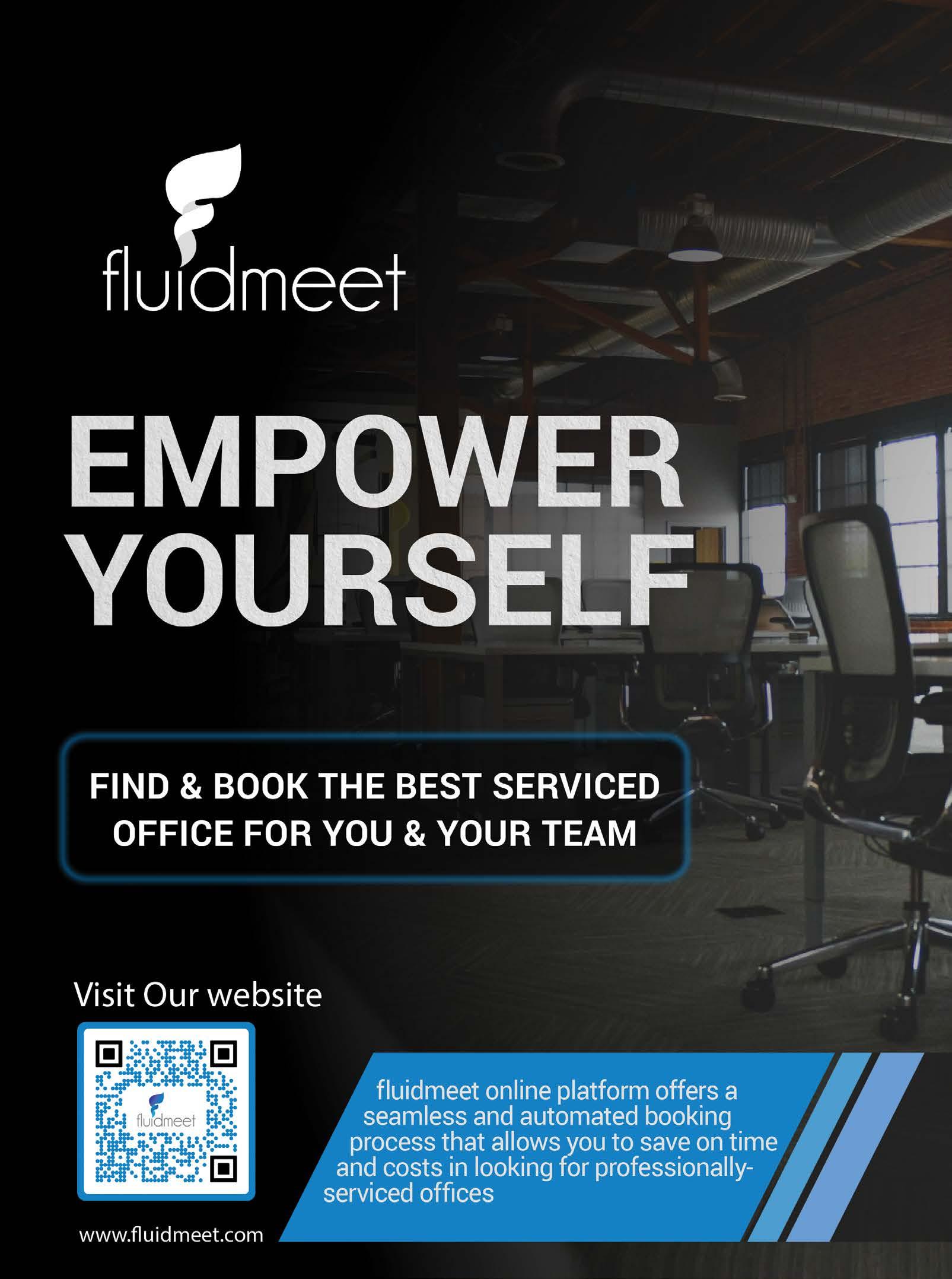

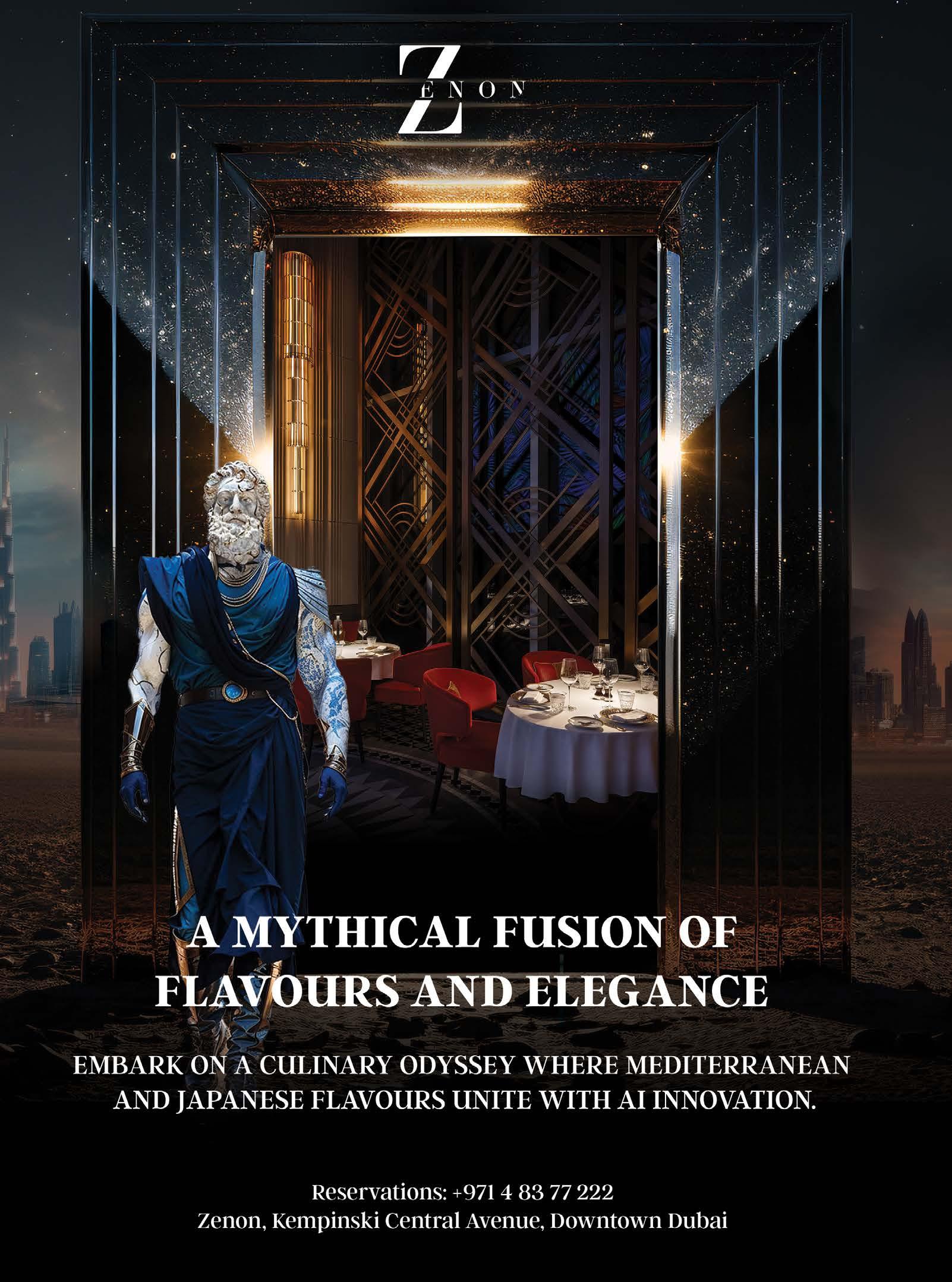
How to spot your type, understand what’s driving you, and what to do about it by ANDY BROWN
I’ve met many entrepreneurs who proudly declare they are “married to the job,” “chained to their desks,” or “perpetually busy.” Like burnout, workaholism has become something of a badge of honor.
The 24/7 hustle is often seen as the only path to success, encouraging entrepreneurs and leaders to prioritize work above all else. They sacrifice time with family and friends, neglect physical health and mental wellness, and push themselves harder and harder.
The consequences? Decreased resilience, stress and deteriorating relationships. I refer to this as running up an “emotional overdraft”—where business successes are subsidized at the cost of personal resilience and well-being.
Understanding your emotional overdraft, and identifying the specific drivers behind your workaholic tendencies, can help you regain balance and improve your overall effectiveness.
There are 10 drivers of an emotional overdraft—each of which can lead to workaholism. These drivers represent ways of thinking and behaving that can either support or diminish your impact in your business.
Overloading your thinking with these drivers impacts your performance as a leader by creating interference in your capacity to perform. Removing the interference allows your natural talents and abilities to shine through effortlessly. Understanding these drivers will help you manage your emotional overdraft and enhance your leadership effectiveness. }}
1/ THE CONTROL-OBSESSED WORKAHOLIC DRIVER: Trust
Entrepreneurs who score highly on this trust driver show up as, “I only trust myself; I don’t trust others.” This leads to micromanaging and reluctance to delegate, stifling team growth and innovation. Constantly worrying about whether work is being done to your standards, juggling too many balls, working late every night, and doing tasks that are other people’s responsibility can be exhausting and demoralizing. This behavior drains your resilience and negatively impacts your well-being.
SOLUTION: Delegate tasks, build trust through accountability and communication, hire for attitude, train well, and structure tasks without micromanaging.
2/ THE URGENT WORKAHOLIC DRIVER: Urgency
For entrepreneurs, the urgency driver leads them to feel that everything is immediate and urgent, often leading to stress and poor decision-making. We’ve all been in situations where the day starts to unravel, pulling us from one crisis to another. This constant state of urgency can make you feel like you’re always acting on reflex, unable to properly solve problems, or think critically about your actions. It’s a stressful way to live and work, often leading to health problems due to prolonged exposure to adrenaline. Moreover, it can demotivate your team and strain relationships at home as your constant state of urgency spills over into your personal life.
SOLUTION: See urgency for what it really is: Understand that what feels urgent is often self-created. Assess whether a situation truly requires immediate attention, or if it can be scheduled. Plan, establish robust processes, and regularly review business plans.
3/ THE EXPECTATIONS WORKAHOLIC DRIVER: Expectation
When you expect to feel stressed a lot of the time, you’re likely to explain it away as the natural lot of a leader. This mindset means you’re not sensitive to the level of stress you’re experiencing, which in turn means that you’re not inclined to do anything about it. It’s a self-fulfilling prophecy.
SOLUTION: Track stress levels, change your mindset, reframe failure, seek professional help, and prioritize self-care.
4/ THE DUTY-BOUND WORKAHOLIC DRIVER: Duty
When you’re ruled by a sense of duty, you often work late because you feel it’s expected of you. You handle other people’s problems because you think you should, and you sacrifice your own needs for the sake of others. This is a classic way to build up an emotional overdraft. As Greg McKeown says in his book Essentialism: “If you don’t prioritize your life, someone else will.” When you’re in constant duty mode, you’re not only exhausting yourself, but also disempowering those around you by not giving them the chance to develop their own sense of responsibility.
SOLUTION: Define personal goals, develop a vision and plan, clarify your role, set up an organizational structure, and challenge your sense of duty.
5/ THE DOER WORKAHOLIC DRIVER: Just Flipping Do It
The phrase “just flipping do it” captures the mindset of leaders who thrive on action and decisiveness. While this can drive progress, it often stems from a need for control, leading to micromanagement and reluctance to delegate, which increases emotional overdraft. Doers can be difficult to work with due to their impatience and lack of concern for others’ input. This can alienate team members and lead to rushed, ill-informed decisions. The habit of always stepping in can create a passive team, perpetuating the belief that only the doer can handle tasks effectively.
SOLUTION: Recognize your behavior, value other approaches, prioritize, delegate, create structure, and take positive pauses.
6/ THE CASH-STRAPPED WORKAHOLIC DRIVER: Cost
“We’re short of money.” “We don’t have the resources.” “I can’t justify the expense.” Cost concerns are a common driver for workaholics, especially when business owners believe they can’t afford the resources they need. This mindset often leads to increased workloads and stress, both for themselves and their teams. For example, you might delay hiring an extra pair of hands due to budget constraints, forcing your current team to handle more work. This not only affects productivity, but also leads to burnout. When leaders focus excessively on saving money, they often end up increasing their emotional overdraft and that of their team. This approach can stall growth and innovation, ultimately costing more in the long run.
SOLUTION: Question budget constraints, ensure accurate financial information, adjust pricing, prioritize spending, view hiring as growth, and protect personal wages.
7/ THE SOLUTION-SEEKING WORKAHOLIC
DRIVER: At a Loss
“I’m out of ideas.” “I’ve no other solution.” When we’re overwhelmed, it’s easy to act on autopilot, and jump to the most obvious solution without considering alternatives. This reactive approach often increases stress and emotional overdraft. Operating under pressure makes it difficult to see the big picture. This narrow focus can lead to
WHEN WE’RE OVERWHELMED, IT’S EASY TO ACT ON AUTOPILOT, AND JUMP TO THE MOST OBVIOUS SOLUTION WITHOUT CONSIDERING ALTERNATIVES. THIS REACTIVE APPROACH OFTEN INCREASES STRESS AND EMOTIONAL OVERDRAFT.”
decisions that add to your stress rather than alleviate it.
SOLUTION: Seek input from others, create a personal board of advisors, recognize and challenge negative self-talk, focus on learning, and reframe problems.
8/ THE LOAD BALANCING WORKAHOLIC
DRIVER: Load-balancing
“I have a short-term need.” “I’m stepping in to fill a gap.”
Load-balancing workaholics
step in to fill gaps during urgent situations, often taking on tasks unrelated to their leadership roles. While it can be necessary occasionally, making a habit of it leads to neglected priorities and increased stress. This behavior can undermine team members, as they miss opportunities to solve problems themselves, leading to dependence on the leader and a cycle of frustration.
SOLUTION: Set up processes to
prevent repeat problems, avoid over-servicing clients, and label your behavior to recognize and address it.
9/ THE EMPATHETIC WORKAHOLIC
DRIVER: Empathy
“I’m part of the team.” “I’m showing care and commitment.” “I feel guilty if I don’t.” Empathy is often praised as a valuable trait, but it can drive your emotional overdraft if misapplied. Feeling guilty about not helping others or getting too involved in their issues can drain your resilience.
Empathy should not stem from a need to be liked or a desire to belong. Leaders who absorb their team’s emotions too deeply can become overwhelmed and ineffective. It’s crucial to distinguish between supportive leadership and over-identifying with employees’ problems. Misapplied empathy can lead to burnout, and undermine your leadership.
SOLUTION: Understand
empathy in leadership, distinguish types of empathy, avoid needy empathy, and remember your team isn’t your family.
DRIVER: Self-Worth
“It makes me feel needed.” “My work is important to me.” Many leaders derive their sense of self-worth from their professional achievements and their perceived importance within their organizations. When you tie your self-worth to your job, your emotional stability becomes vulnerable to the ups and downs of business life. A good week boosts your self-esteem, but a bad week can devastate it. This imbalance spills into your personal life, straining relationships and personal well-being. SOLUTION: Seek constructive validation, identify activities that boost resilience, build a business that runs smoothly without constant intervention, and recognize neediness. Entrepreneurs can achieve success without sacrificing their health by understanding their drivers and making intentional changes. By delegating effectively, setting boundaries, and prioritizing self-care, you can create a sustainable balance that supports both personal well-being and business success.

Andy Brown is an award-winning leadership coach and Amazon bestselling author. His book, The Emotional Overdraft: 10 Simple Changes for Balancing Business Success and Wellbeing, is available on Amazon. For more insights, follow Andy on LinkedIn. linkedin.com/in/andybrownprofile
by BRITTANY HUNT
In the fast-paced business landscape of the Middle East, where entrepreneurial spirits soar and work culture often pushes the limits of dedication, the fine line between hard work and work addiction can sometimes blur.
Understanding and addressing work addiction is crucial, not only for the well-being of individuals but also for the overall health of organisations.
Work addiction, often colloquially referred to as
“workaholism,” is a condition characterised by compulsive work habits that significantly disrupt personal health, happiness, and interpersonal relationships. According to a 2018 study in the Journal of Behavioral Addictions, the prevalence of work addiction is estimated at around 5-8%, varying based on the definitions and criteria used to identify the condition. These figures underline a critical challenge within the corporate sector, one that resonates deeply in regions fueled by robust economic ambitions like the Middle East.
Those who are addicted to their work are distinct from those who are highly dedicated or hard workers, primarily in their compulsivity and the negative impact the work has on an individu-
precursor to both depression and anxiety. When individuals consistently overextend themselves to meet demanding work obligations, they may experience prolonged periods of stress that can deplete their mental and emotional reserves. Re-
engage. Without these periods of rest, individuals are less able to cope with daily stresses, and over time, this can lead to severe mental health issues. In the Middle East, where long work hours and high expectations are common,
addiction—such as declining physical health, decreased productivity despite long hours, or strained relationships due to work—can help in early identification and intervention.
al’s life. While dedication and hard work are characterized by a conscientious commitment to job responsibilities, they are generally balanced with other life activities, and do not compromise personal health or relationships. In contrast, work addiction involves an obsessive need to work excessively, driven not just by professional commitment, but by an internal compulsion that disregards health, personal happiness, and social interactions. Dedicated workers are able to detach from work, enjoying and valuing their downtime, whereas workaholics struggle to disengage, often resulting in stress, burnout, and anxiety. Understanding this distinction is crucial for maintaining a healthy work-life balance, and ensuring that professional enthusiasm does not evolve into a harmful addiction.
The implications of work addiction extend beyond personal health, impacting organizational effectiveness. Work addiction and excessive work pressures often lead to chronic stress, which is a well-documented
search indicates that 12 billion productive workdays are lost annually to mental health issues such as depression and anxiety, costing the global economy nearly US$1 trillion. This statistic is particularly concerning in the context of the Middle East, where the intense drive to innovate and succeed places immense pressure on individuals, potentially exacerbating these mental health challenges. Moreover, the lack of recovery time in cases of work addiction means that the natural repair mechanisms, which are triggered during rest periods, do not have the opportunity to
the absence of a balanced work culture can increase not only the risk of these mental health disorders, but also the productivity and effectiveness of organizations. When the drive to innovate and succeed is paramount, and employee wellbeing is so closely linked to business success and growth, it is imperative for leaders to foster a balanced work culture. Here are a few things that business leaders can do to achieve just that:
1/ ENSURE EARLY IDENTIFICATION AND SUPPORTIVE POLICIES Implementing policies that recognize the signs of work
2/ PROMOTE WORK-LIFE BALANCE Encourage a culture where work-life balance is prioritized. Simple strategies like flexible work hours, mandatory time off, and support for mental health not only enhance productivity but also prevent burnout.
3/ OFFER REGULAR TRAINING AND RESOURCES Provide training sessions that help employees manage time effectively, set achievable goals, and detach from work after business hours. Access to counselling and mental health resources can also support those struggling with work addiction.
4/ LEAD BY EXAMPLE
Business leaders should model the work-life balance they advocate. By setting an example, leaders can directly influence the workplace culture, promoting healthier work habits among employees.
5/ PROVIDE MENTAL HEALTH ASSESSMENTS Regularly offer confidential mental health assessments as part of health benefits packages. These assessments can help
identify employees who might be at risk of work addiction, allowing for timely interventions.
6/ CREATE NO-EMAIL HOURS Establish specific times, especially during evenings and weekends, when sending non-urgent work emails is discouraged. This helps enforce boundaries between work and personal time, encouraging employees to truly disconnect.
7/ ENCOURAGE REGULAR BREAKS Promote a workplace culture where taking breaks is normalized and encouraged. For instance, set up break rooms or quiet spaces where employees can relax without work interruptions.
8/ MONITOR WORKLOADS Regularly review employee workloads to ensure they are manageable. Utilize project management tools to track progress and identify when the team might be overstretched or need additional resources.
9/ FOSTER A SUPPORTIVE ENVIRONMENT Cultivate an environment where seeking help is seen as a strength, not a weakness. This includes training managers to recognize signs of work addiction, and providing them with the tools to help affected employees.
For organizations in the Middle East, addressing work addiction is not just about enhancing employee welfare, but also about boosting productivity and sustaining growth. As the region continues to advance on the global economic stage, the ability to balance intense work demands with effective health and wellness strategies will be key to enduring success.

Brittany Hunt is a therapist at Clinic Les Alpes, an exclusive medically-licensed sanctuary in the Swiss Alps. Situated in Les Avants, Clinic Les Alpes offers a secluded escape with panoramic views of the mountains and Lake Geneva. Hunt is a mental health and addictions clinician from New Zealand, who has worked in a variety of settings including residential rehabilitation centers, hospitals, and outpatient mental health services. She focuses on using a holistic therapeutic approach to supporting clients, and empowering them in their recovery and growth. Passionate about client empowerment, Hunt strives to always maintain a strength-focused perspective, and work in collaboration with her clients to help them achieve their best lives. cliniclesalpes.com
TruKKer, the MENA's largest land freight ecosystem, inks partnership with Dubai's Roads And Transport Authority

TruKKer, the MENA’s first and largest digital land freight network, has announced the signing of a strategic publicprivate partnership (PPP) with Dubai’s Roads and Transport Authority (RTA), the government entity that is in charge of planning and executing transport and traffic projects in Dubai. With the partnership signed by Abdulla Yousef Al Ali, CEO, Licensing Agency, RTA, and Gaurav Biswas, founder and CEO, TruKKer, the move is set to result in the establishment of a new digital platform that will focus on improving the delivery of commercial transport services in Dubai.
The new platform is expected to leverage cutting-edge technology that will integrate all Dubai-based fleet service providers and vehicles into one unified system. Business-to-business (B2B) and business-to-consumer (B2C) customers will thus be able to experience wider and more streamlined access to road freight transport services.
“RTA is always keen on elevating the standard of services offered to individuals and corporate customers,” said Al Ali. “We intend
to align this initiative with the top international practices driven by a commitment to developing a refined network and systems to provide sustainable and smart commercial transport solutions for individuals and businesses. It requires delivering sophisticated yet user-friendly services to a diverse spectrum of the community.”
TruKKer’s Biswas too spoke about his expectations from this PPP, and what it could entail for Dubai’s commercial transport landscape. “This agreement marks a strategic move towards providing advanced yet user-friendly solutions to meet the varied transportation needs of individuals and businesses in Dubai,” Biswas said. “Through automation, the platform will provide real-time and actionable information to users, ensuring a smooth journey for both customers and operators. This initiative thus prioritizes user convenience, ensures reliability with registered service providers, and aligns with the long-term commitment to environmental, social, and governance principles for TruKKer and RTA. We will transform intra-city transport services across Dubai and soon across other regional metropolises.” trukker.com | rta.ae


STEVE FLAWITH
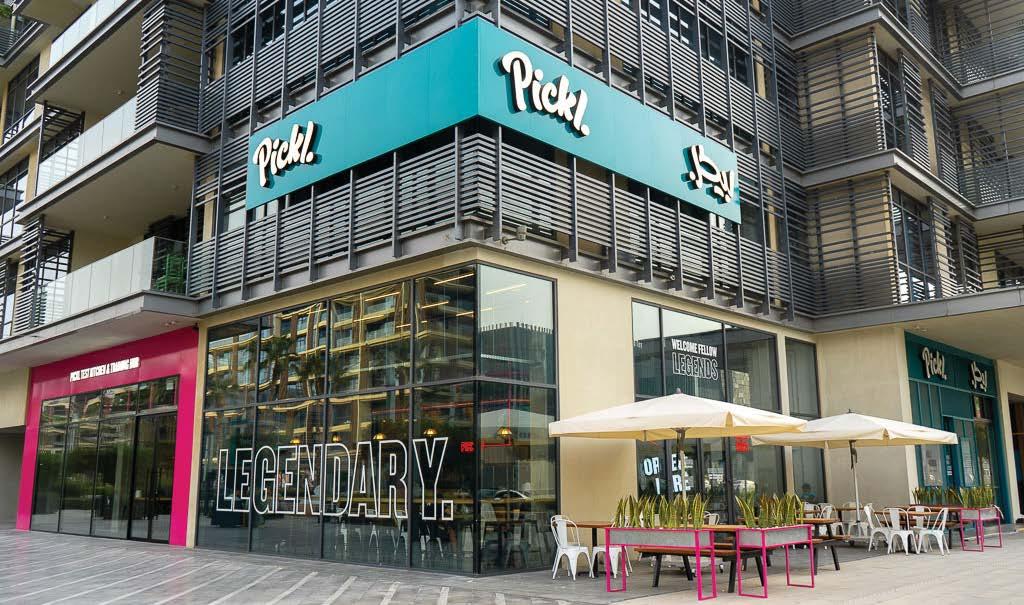
No matter the sector, the size or the success of any company, the most common point that comes around each time remains the same: the brand matters.
It’s no different in the restaurant industry, at least to a certain size. We all see the power and might of the big chains, and the money thrown at brand creation may be intimidating to the small and medium players out here. But when you are starting your first business, this all can seem like a galaxy away, and each misstep can feel cataclysmic.
And yet, even five years ago when we at Yolk Brands were setting up our humble outfit, the message was clear; we aren’t here to start a restaurant, we’re here to build a brand. But why does that matter anyway? Here’s an explainer:
1/ A brand is more than a logo.
We all get caught up in this, and so do the very designers creating the logo. Don’t get me wrong, it is important, but a brand is not a logo. A logo is a start to your branding journey. It all comes down to a healthy mix of product, marketing, tone of voice and how people really see and engage with you. What point of difference will your brand have in the market you’re in? How do you create that unbreakable proximity and connectivity to your audience? What do you really stand for, and how do you communicate that? These questions are important to ask, and they will help you to establish your identity in the market. Remember, brands are all-encompassing; a successful brand should become part of lifestyle, ever so subtly. Brands garner trust over time, and this directly contributes to your revenue down the line. When you speak to your branding agency, look deeper than the aesthetics of the logo, and push the boundaries of identity.
2/ It’s not just a name. It’s people.
Brand names matter, sure, but that’s just the surface of it all. We’ve spent countless hours writing, re-writing, scribbling out, and whiteboarding the name. Even to the point of going through a full creative cycle of logo development just to wipe it out and start again. Yet, you have to ask yourself would Apple be as successful as they are today if they were called Flipper?
I’m sure they would, simply because names become logos, logos become products, and products, if you hit it just right, become a brand. My true drive for brand creation comes from people. It’s the people that surround you, the ones you bring in, the ideas you encapsulate. For the most part, wholehearted creativity doesn’t necessarily come in isolation. So, as you talk about a brand being people-led, it folds in both ways; one side is about the people that build the creative, the product, the tone of voice, and the vision, while the other is about the people you are talking with, not to. Audiences want to feel included in every step of the process, and they want to see a piece of themselves in what you produce. It’s not about just finding a catchy hook and idea anymore, it’s more so about being a mirror for the customer.
3/ Let brands breathe— over a 6-9 month period
Breathing room is important, don’t neglect
this. Don’t wade in with stringent brand guidelines. Instead, be flexible because, at the end of the day, you don’t know what your brand is yet, and your audience certainly doesn’t know either.
Learn from the process, listen to the people, understand and celebrate the wins, but also learn from the failures. In time, you’ll pivot and create more, you’ll nurture and master the position of who you want to be. Too many people want to build walls around their creations, but ultimately, audiences crave being let in with complete transparency.
4/ Don’t be stubbornunderstand the market, take input, develop Picture this: you’ve just launched your very own brand, and it now feels like no one else truly gets it. Product-wise, you’re now on the market, and your advertising machine is now officially at full throttle, but it’s just not clicking with audiences. The vision (both shortterm and long-term), the trajectory, the brand’s essence—you’re the founder that’s poured everything into this after all, so you should have all the answers, right?
Think again. I’m here to tell you this mindset is a trap we all are prone to fall into at some point. While being laser-focused on achieving your vision is key to getting there, there’s a very fine line between that and stubbornness. If you ever cross that line, you may very well, unwillingly, be
→ Serving up bucketfuls of fresh fried chicken, BonBird is the
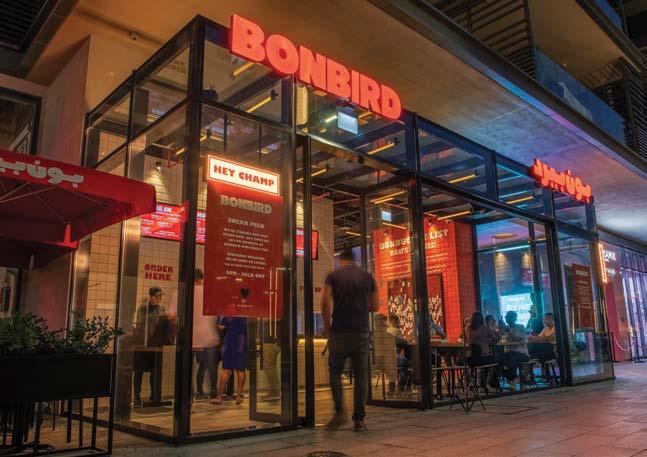
giving your startup a small life cycle.
5/ Conversation matters—visual and copy
The bandwidth of a social conversation nowadays is very short; it’s the 24 hours of a story on Instagram, it’s a post that someone would scroll over in 10 seconds, it’s a Reel or a TikTok video that you can capture people with in less than 15 seconds. The goal is to make it count, and build the conversation with those who follow you, giving them a reason to keep at it. It’s time we claim back the right of copy, inspire people with your words, as much as you do with the visuals and video.
6/ Trust your gut
This one is on you. As much as it’s an intuition, this also leans into more tangible aspects such as market trends, people that surround you, and opportunities that arise. Challenge yourself, leave a print, and inspire those who work with you and are part of your brand. Believe in what you do, because you’re carrying
this brand through people, through platforms, and you’re becoming a part of someone’s lifestyle habits.

Stephen Flawith is the founder and CEO of Yolk Brands, an innovator in the F&B industry within the GCC and beyond. Starting with a single Pickl burger joint in Dubai’s Jumeirah Lakes Towers neighborhood in 2019, he expanded to 22 locations across the GCC, including Qatar, Bahrain, and Egypt, in just five years. Under his leadership, Yolk Brands introduced several Dubai-born brands, including BonBird Chicken Shop, offering top quality fried chicken, and Southpour Coffee Roasters and Juice Bandits. The acquisition of 1762 Deli in 2023 further diversified Yolk Brands. Flawith’s passion for creating brands, not just restaurants, and his strategic vision have driven Yolk Brands’ rapid growth and global recognition. yolkbrands.com


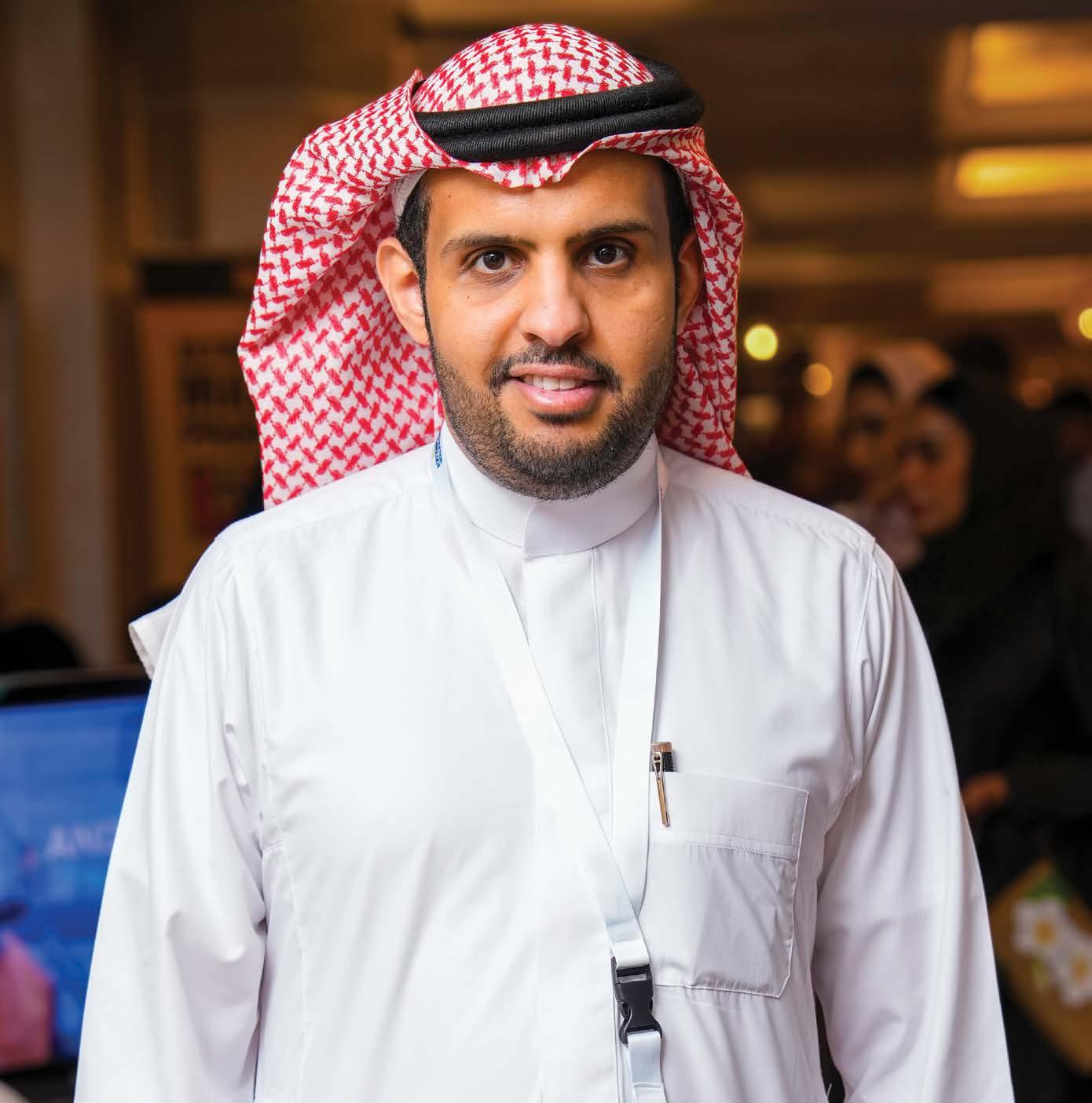
WakeCap founder and CEO Dr. Hassan Albalawi is building a business centered on improving workforce productivity in the construction industry by TAMARA PUPIC
Back in 2017, Saudi entrepreneur Dr. Hassan Albalawi founded the Dubaibased construction technology (aka Contech) startup WakeCap out of a conviction that technology held the key to improving the future of the construction industry. And while the construction sector may seem like a good choice for testing one’s entrepreneurial strengths (keeping in mind that it is globally valued at US$12 trillion and that it employs 200 million people), it is, however, also known to rely on offline and inefficient processes that lead to miscommunication, poor collaboration, and worker shortages, and ultimately to crews wasting hours per week on non-productive tasks. “I was convinced that technology could mitigate risks and improve operational processes on sites, while saving site owners money,” Dr. Albalawi says. “It inspired me to create a solution–and a company–that would improve the industry for everyone in it.”
This is how Dr. Albalawi went on to launch WakeCap with co-founder Ishita Sood by his side, and it now has offices in Dubai, Riyadh, and San Francisco. According to Dr. Albalawi, such a structure has allowed his company to leverage the two locations of the Middle East’s booming construction industry, while also being right in the centre of one of the most advanced technology capitals of the world. In terms of its offering, WakeCap provides an internet of things (IoT)-based enterprise solution to monitor workforce activity, and thereby collect profit-impacting data on actual hours, progress, and safety, in large construction projects. In gathering data through a knob that attaches
to a standard hard hat worn by site workers, WakeCap offers real-time visibility and highly accurate project data through its innovative wearable and cloud solution. Today, the WakeCap offering is used on more than 30 mega sites and giga sites in Saudi Arabia and the United States, each with more than 2,000 workers per project, and it has cumulatively logged over 70 million worker hours. “One of the biggest developers in the region said that by implementing WakeCap, they reduced the number of ‘non-productive’ worker hours on site from 3.5 hours a day to just 45 minutes,” Dr. Albalawi shares. “On a site with 1,000 workers or more, that’s a significant cost saving. We

always believed that improving visibility and transparency benefits everyone, from site owners to consultants and site workers, and seeing how our technology has done exactly that is incredibly motivating.”
However, Dr. Albalawi’s entrepreneurial path was filled with challenges, which included the industry’s resistance to change, as well as its relatively slow adoption of technology. “Many construction stakeholders have traditionally been wary of digital solutions, partly because very few have catered specifically to the unique and dynamic nature of construction sites,” he explains. “There’s also a general perception that technology can’t address each site’s uniqueness, which adds to the hesitancy. To overcome these challenges, we focused on education and demonstrating clear value. Change management in construction cannot be forced; it requires a strategy that highlights gradual improvements. By showing how our solution saves time, and integrates seamlessly into existing site infrastructure (taking less than a minute per worker to set up without disrupting workflows), we were able to gain trust and buy-in from stakeholders.”
Given Dr. Albalawi’s own experiences in this domain, he advises other entrepreneurs in the sector to have a deep understanding of the issues that the industry faces.
“Understand where the challenges come from, and why (don’t just stick to the surface level), and tailor your solutions to address these pain points directly,” Dr. Albalawi says.
“Then, I’d say gradual implementation is more likely to get accepted and integrated successfully. Lastly, demon-
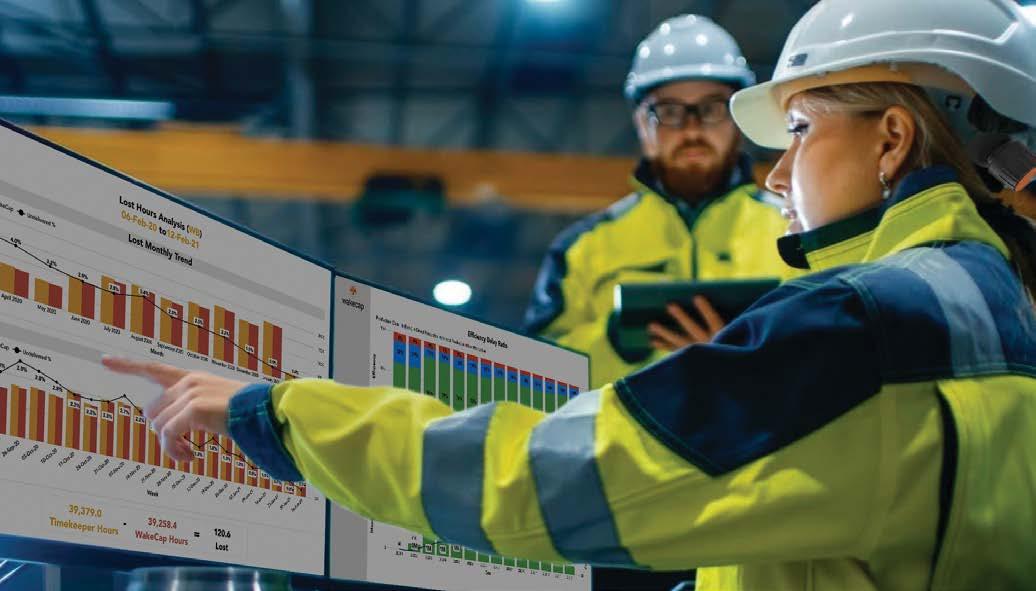
↑ WakeCap was founded in 2017 with the aim to answer job site digitization challenges using emerging technologies. Its innovation focused on the development of a non-intrusive technology that could be implemented to existing job site operations to create a turnkey solution that adds value to operational excellence.
strate the value of your solution with the use of reliable data to show tangible benefits. Your transparency in this aspect also builds trust.”
In June 2024, WakeCap acquired Crews by Core, which is a Palo Alto-based
platform for construction operations,” Dr. Albalawi adds. “This acquisition allows us to integrate AI-powered field scheduling with our existing IoT solutions, providing a single platform that supports owners and contractors throughout project delivery. By
prises, including fintech company Paypal, traffic navigation startup Waze, internet browser Google Chrome, and big data analytics software platform Palantir. “They [Eisnor and her team] know how to scale technology platforms,” Dr. Albalawi points
artificial intelligence (AI)powered project delivery platform for the construction industry. Its solution is expected to allow WakeCap to create the world’s most comprehensive software as a service (SaaS) and IoT solution for construction mega projects.
“Acquiring Crews by Core significantly expands WakeCap’s capabilities, making us the most comprehensive
combining our technologies, we bring the latest cuttingedge tools available worldwide to the Middle East, enhancing productivity, safety, and profitability on job sites.” When making the decision about acquiring Crews by Core, Dr. Albalawi says that it helped knowing that its founder Di-Ann Eisnor and her team had worked on some of Silicon Valley’s most notable enter-
out, which is a nod to how he sees the acquisition helping WakeCap in the long term. For other entrepreneurs negotiating an acquisition deal, Dr. Albalawi advises them to go with trust when it comes to the “other” side, but also to verify it. “Thoroughly investigate potential partners,” Dr. Albalawi explains. “Ensure they share your values in order to create a seamless and
harmonious working relationship.” Plus, having a common goal would enhance synergy and effectiveness, with Dr. Albalawi also highlighting that any acquisition deal should lead to accelerating the }} acquirer’s core business. “Scale up together, and leverage each other’s strengths,” he says. “Work collaboratively to harness opportunities, ensuring that both entities benefit from what the other can offer.”
WakeCap’s acquisition of Crews by Ciore is considered to be one of the first acquisitions of a Silicon Valley tech startup by a Saudi company, and according to Dr. Albalawi, it is a testament of the innovative potential birthed by the growth of the construction sector in the GCC. Through the acquisition, WakeCap will open an R&D headquarters in Silicon Valley, though the technologies of these two companies have already been deployed across large sites and mega projects in the United States, Saudi Arabia, UAE, and Japan, managing tens of thousands of workers performing millions of hours of labor each year. Customers include energy giant Saudi Aramco, Saudi Arabia’s Public Investment Fund-owned developer Jeddah Central Development Co., Japanese construction companies Kajima and Takenaka, and New York-based contractor Apex Building Group. Such accomplishments bode well for the future of
→ WakeCap’s solution is designed to improve safety, efficiency and productivity on construction sites, manufacturing facilities, oil and gas operations, and mining sites–even if they’re underground.
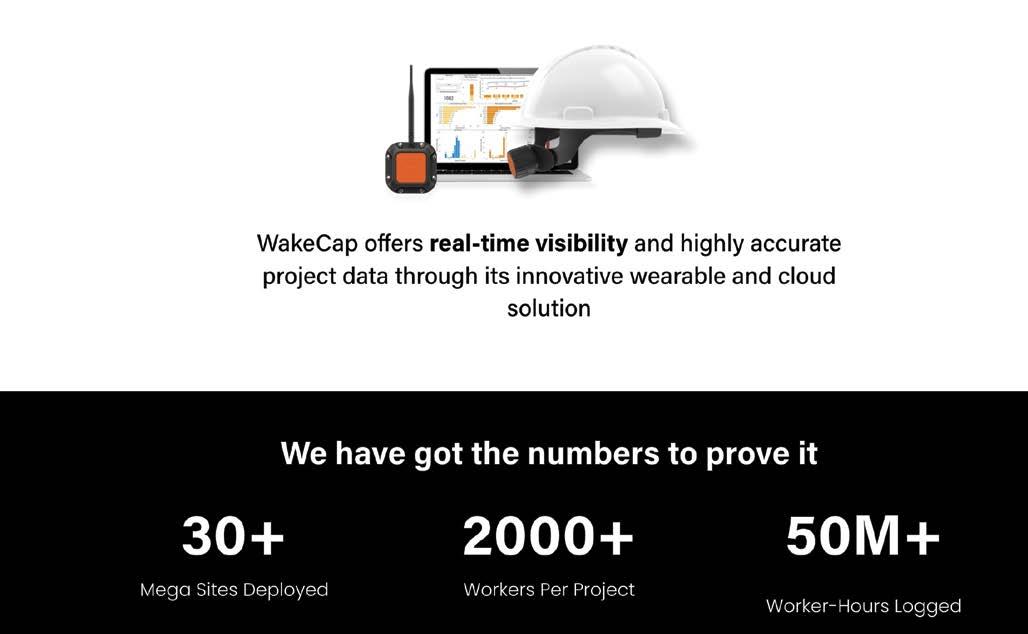
I WAS CONVINCED THAT TECHNOLOGY COULD MITIGATE RISKS AND IMPROVE OPERATIONAL PROCESSES ON SITES, WHILE SAVING SITE OWNERS MONEY. IT INSPIRED ME TO CREATE A SOLUTION–AND A COMPANY–THAT WOULD IMPROVE THE INDUSTRY FOR EVERYONE IN IT.”
WakeCap, and Dr. Albalawi believes that the industry at large is going to benefit as a result as well. “The contech sector in the GCC is undergoing significant transformation, particularly in Saudi Arabia,” he says. “Initiatives like the National Transformation Program [an economic action plan included in Saudi Arabia’s Vision 2030 development plan] are crucial in driving digital transformation, enhancing governance, and improving resource sustainability. These initiatives align with Vision 2030, which aims to provide innovative housing to over 85% of the urban population. This creates immense opportunities for proptech companies.”
WakeCap founder and CEO Dr. Hassan Albalawi shares his tips for entrepreneurs
} Empower your team "As a technology company, fostering an innovative work culture is essential. Our diverse team, drawing expertise from various global regions, plays a critical role in our success. Ensuring that each team member feels valued and empowered to contribute has significantly driven our growth and the continuous improvement of our solutions."
} Collaboration is key "Expanding globally has underscored the importance of strategic partnerships. It helps
solidify our global presence and enables us to stay ahead of the game. By collaborating with industry leaders, we’ve been able to expand our suite of solutions and harness cutting-edge technologies."
} Focus on gradual change, and demonstrate clear value "This has been crucial in overcoming resistance to new technologies. In an industry traditionally wary of digital solutions, showing how our IoT-based innovations can seamlessly integrate into existing workflows and improve safety and productivity has been vital. This approach helped us to build trust and encourage our customers to adopt new technologies."


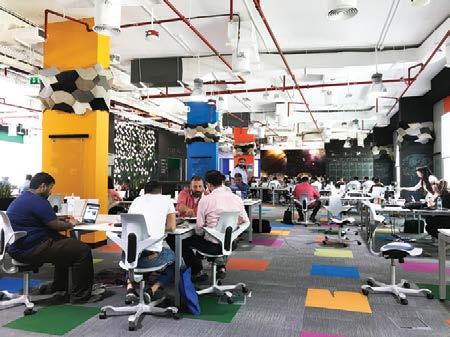


Lessons from Impact46's investment strategy by
BASMAH AL SINAIDI
Venture capital (VC) firms have often been described as the lifeblood of innovation, providing not only funding, but also strategic support to startups with the potential to disrupt markets and industries. And the ultimate testament to a VC firm’s success is its ability to guide companies to “successful exits,” often through a sale or an initial public offering (IPO). We at Impact46 are committed to supporting top Saudi startups and reinforcing the incredible potential they have. As a leading VC firm in Saudi Arabia, Impact46 has proudly backed startups on their path to the stock market, which is a milestone that presents itself as a celebration of the company’s growth and legitimization of its sustainability.
The first investment and exit we did at Impact46 was through the Saudi Arabia-based financial services marketplace Lendo. Impact46 was the first institutional backer for the company in 2019, recognizing the fintech revolution opportunity in Saudi, and the impact of crowdlending on the SME sector. We invested at the idea stage, and exited after multiple investment rounds. This exit allowed the company to better align with its other stakeholders, and demonstrated the importance of creating
value, and attracting potential buyers or investors who recognize that value.
The second exit for Impact46 was Tamara, another startup where we were the first institutional investor who invested at the ideation stage, and then followed on in further multiple rounds, before selling our shares to a global payment service provider. This exit emphasized that a local player like Tamara has the consumer needs understanding as well as the technology expertise required for transforming retail experiences, and it also highlighted how Saudi startups could effectively cater to contemporary consumer needs. This transaction in 2021 sent waves through the startup community, as it showed the viable path for local and global collaborations in the fintech field.
Additionally, KSA-based online food delivery company Jahez’s debut on the stock exchange—with a market cap of SAR8.9 billion—allowed it to achieve a stellar exit within three years of impact46’s investment, which amounted to SAR137 million in exchange for 40% of the company. Securing an IPO in the Saudi parallel market (Nomu) is a milestone showcasing the strategic vision in identifying scalable ventures. As one of Saudi Arabia’s leading food delivery apps, Jahez demonstrated incredible growth dynamics that aligned with global trends towards on-demand services. The company’s successful IPO is indicative of a healthy appetite
amongst investors for innovative tech-driven companies from Saudi Arabia.
Our most recent listing transaction is KSA-based fintech firm Rasan’s public listing on the primary Saudi market with a valuation range up to SAR2.8 billion. Impact46’s strategic investment of SAR90 million in the company in 2021 anticipated the pressing need for the insurance sector to adopt tech solutions. Rasan’s advancements in tech-driven insurtech solutions appeal to modern customers’ evolving preferences, and demanding dynamic response from traditional sector players. Today, Rasan stands as the first and largest insurance aggregator in KSA by gross
written premiums (GWP), boasting a market share of approximately 47% in motor for its insurance platform, Tameeni.com.
The past transactions only emphasize the promising future of Saudi Arabia’s entrepreneurial ecosystem. These evolutions in the market demonstrate the global potential of Saudibased startups, and they also attract further investment and support from both local and international players. The opportunity to pave a local homegrown exit , and to forge a path towards an international exit have all been demonstrated by the previous portfolio and startup scene. Now, we look forward to fostering further growth and development with the upcoming revolu-
tionary technology companies in Saudi Arabia.

Basmah Al Sinaidi is a Managing Partner and Head of Asset Management at Impact46. Founded in 2019, Impact46 has quickly established itself as a leading venture capital firm in the Kingdom of Saudi Arabia, and gained the distinction of being one of the first asset management companies to be authorized by the Capital Market Authority (CMA). Impact46 focuses on alternative investment opportunities in Saudi Arabia, investing in theme-specific venture capital and private equity opportunities from the seed stage to mature, profitable businesses. impact46.sa
AN IPO IN THE SAUDI PARALLEL MARKET (NOMU) IS A MILESTONE SHOWCASING THE STRATEGIC VISION IN IDENTIFYING SCALABLE VENTURES.

“THE PLAN COULD BE USELESS, BUT PLANNING IS ESSENTIAL.”
WINGMAN EXECUTIVE FOUNDER
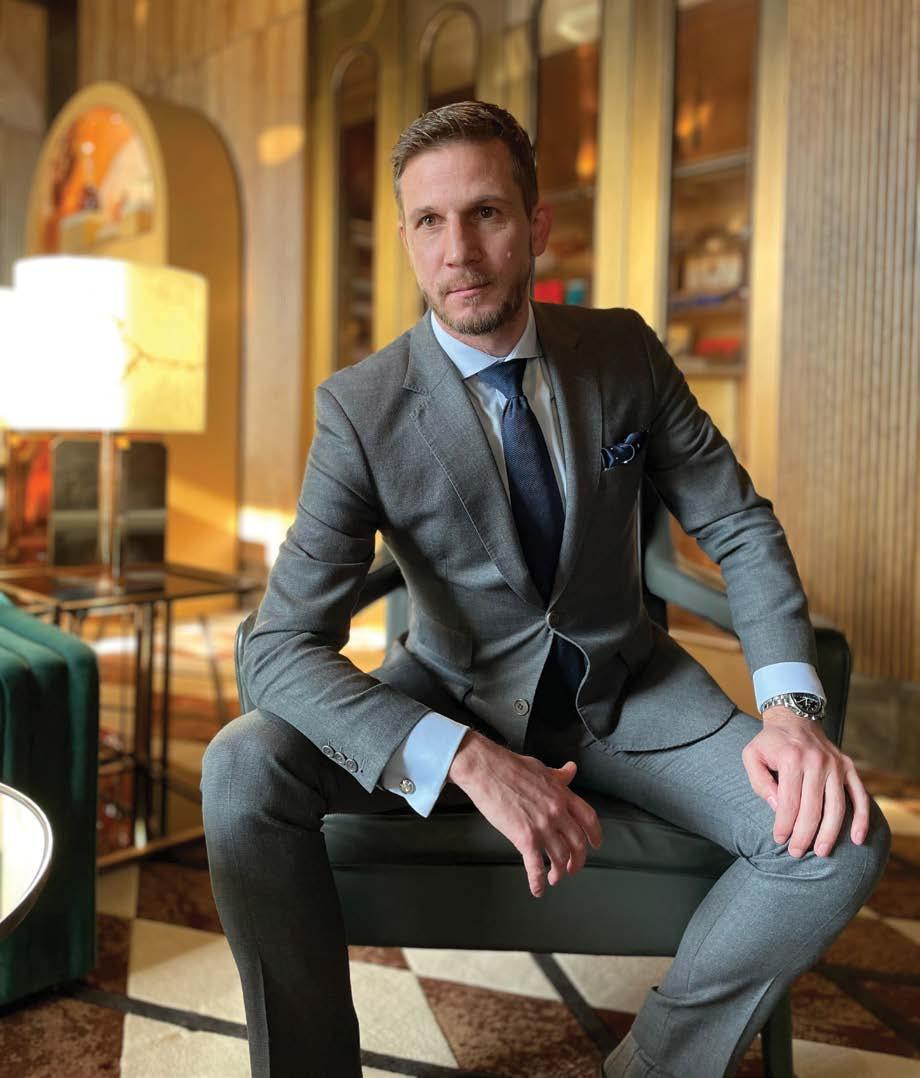
In the second episode of our Paradigm podcast series, Entrepreneur TV Middle East explored the remarkable journey of Paul Littlejohn, founder of Wingman Executive. Littlejohn's career is a testament to the fusion of military discipline and corporate strategy, where he has excelled in both the high stakes realm of military aviation, as well as the dynamic boardrooms of multinational corporations.
by BY MINA VUCIC
From Fighter Pilot to Corporate Strategist
Littlejohn’s career began in the Royal Air Force, where he served as a fighter pilot and squadron leader. His early years were marked by intense decision-making and strategic planning under extreme pressure, experiences that laid the groundwork for his future leadership style characterized by agility and resilience. Transitioning seamlessly from the cockpit to the boardroom, Littlejohn brought a unique perspective to companies such as Emirates Group, Meeting Point International, and PA Consulting. Here, he played pivotal roles in driving operational efficiencies, enhancing governance standards, and integrating cutting-edge technologies into business operations.
As a leadership consultant, Littlejohn goes beyond traditional mentoring. His reputation as a visionary problem solver and strategist stems from his ability to uncover innovative solutions and explore untapped opportunities. This approach has earned


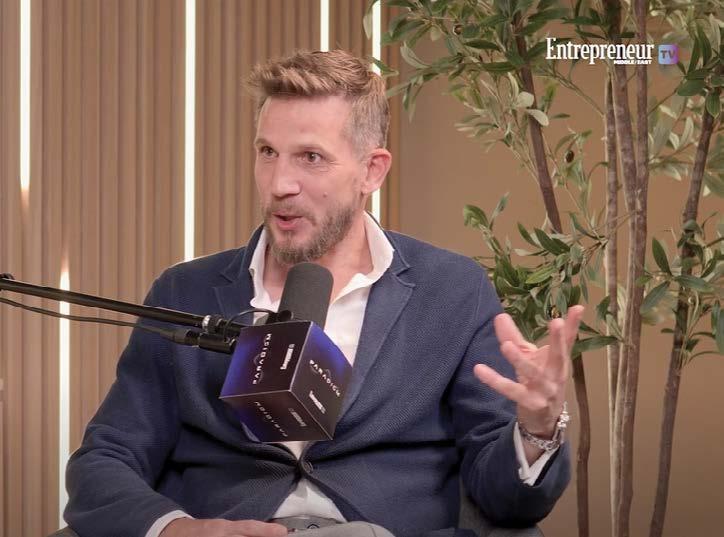
him recognition across organizations, where he has consistently enhanced operational performance and profitability.
Littlejohn’s expertise extends to strategic leadership, operational excellence, and high-stakes decision-making. His people-first approach has revolutionized leadership dynamics across diverse sectors, significantly improving business outcomes and employee satisfaction. By championing team empowerment and development, Littlejohn has helped companies reduce customer complaints, enhance productivity, and boost employee engagement, ultimately amplifying profits.
Currently serving as the founder and CEO of Wingman Executive Consulting, Littlejohn remains dedicated to mentoring and advising senior executives and high-potential leaders. His extensive background uniquely positions him to offer insights that blend military precision with corporate agility, providing clients with a competitive edge in today’s dynamic business environment.
Littlejohn’s mentorship is particularly valued by leaders navigating complex challenges or seeking to elevate their organizations. His strategic acumen and people-focused solutions make him an ideal partner for executives committed to driving meaningful change and achieving sustainable success.
Littlejohn’s journey from fighter pilot to executive consultant exemplifies the transformative power of leadership rooted in adaptability, resilience, and visionary thinking. His ability to navigate the rigorous demands of military aviation and translate those skills into corporate strategy underscores his role as a guiding force in today’s business landscape. Through his Paradigm podcast episode, Littlejohn inspires leaders to embrace innovation, foster team empowerment, and drive positive change within their organizations.
} Littlejohn’s journey from a fighter pilot to an executive consultant exemplifies how diverse experiences can shape a robust leadership style
} The importance of visionary problem-solving in leadership consulting, going beyond conventional mentoring
} Micromanagement can stem from a desire for control, but it often leads to a toxic work environment, and stifles employee creativity
} According to Littlejohn, leadership is all about adaptability and resilience
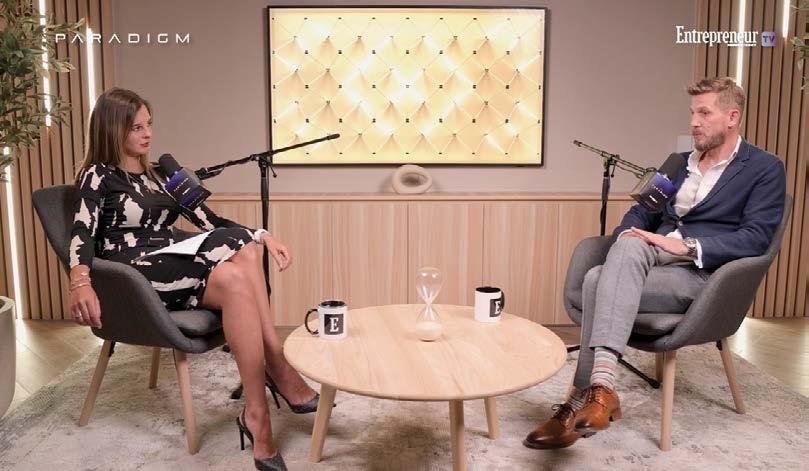




Mina Vucic is the Director of Production and Multimedia at BNC Publishing. She hosts Paradigm, an Entrepreneur TV Middle East podcast series that delves into the triumphs and challenges on industry pioneers in the dynamic world of business and entrepreneurship. instagram.com/entrepreneurtvme
by MICHAL SOBIERAJ
Ask any business owner what the most important element of commercial success is, and you’ll probably get a number of different answers. Some may say a great product or service, others might highlight the importance of a sound marketing and sales strategy, and there may be a few that emphasize the significance of strong leadership and teamwork.

Of course, these are all valid points. Yet, amidst this diversity of perspectives, there’s one fundamental element that underpins them all: effective financial management.
The Chief Financial Officer (CFO) is a company’s ultimate asset for growth. They drive a business’s sustained success by providing critical financial oversight that aligns financial goals with business objectives.
While some businesses opt for a traditional full-time CFO, others are increasingly unlocking the power of a more flexible solution: the fractional CFO. Unlike their full-time counterparts, fractional CFOs offer tailored expertise on a part-time basis, providing strategic financial guidance without the burden of a long-term commitment or the hefty price tag of a full-time executive.
Many companies are already seeing the value of this. According to a survey by Deloitte, over 80% of mid-market organizations have used or are considering using interim executives. And a separate survey by Clutch revealed that 37% of businesses outsource accounting functions, while tax ranks as the second most outsourced business process at 61%.
What all these companies understand is that high-level financial expertise is critical to business success, and that without it, even the most promising business can falter. But
what exactly does a fractional CFO do, and why does your company need one? Here’s a primer.
One of the main responsibilities of a CFO is to optimize a company’s financial structure and improve cash flow. This is something that too often gets neglected when a company doesn’t have access to a finance professional.
Attention tends to be directed towards revenue-generating areas like product development and sales, meaning cash flow issues can go unnoticed until they hinder growth opportunities, create bottlenecks with clients or suppliers, or cause more severe problems. In fact, a study by U.S. Bank found that 82% of business failures are due to cash flow issues. Using a fractional CFO, you can ensure your business maintains operational stability, and avoids disruptions from liquidity problems.
Beyond managing day-to-day finances, fractional CFOs play a big part in improving the overall value of a company. A study by the National Bureau of Economic Research found that companies with effective financial oversight experienced a 20–30% higher valuation than those without.
Fractional CFOs do much more than just balance the books. They refine revenue models, identify high-growth opportunities, and streamline operations, which can lead to profit margin improvements of up to 15%, according to data from Deloitte. Additionally, by aligning financial goals with broader business objectives, they help build a sustainable and scalable business model.
RAISE CAPITAL This combination of a solid financial foundation and clear growth strategy is vital to attracting investors, and securing the necessary funding to drive expansion. Too often, companies stagnate because they can’t attract funding or scale effectively due to a lack of expert financial guidance.
A report by CB Insights backs this up. It found that 38% of startups fail because they either run out of cash or fail to raise new capital.
Fractional CFOs can help with this. As well as preparing detailed financial projections and crafting persuasive business plans, they are experts at cultivating relationships inside and outside the company, and then leveraging those networks to connect with potential investors.
They can also help to identify the best funding option, whether that be a bank loan, venture capital or an initial public offering (IPO), and then securing the best terms through market research and negotiation skills.
TIONS,
Navigating mergers, acquisitions, and exits is another area where fractional CFOs bring huge value. Complex transactions like these require skillsets that often go beyond the capabili-
ties of typical in-house teams. According to Harvard Business Review, between 70% and 90% of all mergers and acquisitions (M&A) fail to achieve their projected goals, largely due to poor financial planning and integration.
Fractional CFOs play a pivotal role in overcoming these challenges by conducting comprehensive financial analyses, and ensuring all potential risks are assessed before any deal is made. They also help to structure the transaction in a way that maximizes value and aligns with the company’s long-term objectives.
In the case of exits, whether through a sale or an IPO, a fractional CFO ensures that the company is financially attractive to buyers or the public market. They can oversee the preparation of detailed financial documents, ensure regulatory compliance, and manage the financial narrative presented to potential buyers or investors.
COMPLIANCE AND CORRECT FINANCIAL REPORTING Investors and stakeholders thrive on transparency.
Fractional CFOs foster trust by ensuring financial reports are accurate, transparent, timely, and clear, fixing any anomalies if necessary. They’re also tax optimization wizards, helping navigate tax codes, and legally minimize a company’s tax burden. This includes ensuring accounting and tax compliance and optimizing processes within the department, including hiring, training and managing people.
WHY CHOOSE
CFO OVER A PERMANENT HIRE? The proficiencies summarized above are just
some of the diverse attributes fractional CFOs bring to the table. Beyond these specialized skills, they also handle all core financial needs such as budgeting, resource allocation, financial reporting, and development of key performance indicators (KPIs).
One of the great advantages of a fractional CFO over the full-time equivalent is that they usually possess a more diverse skillset, having often worked with multiple clients across various industries and business stages. This cross-functional expertise is invaluable for businesses looking to grow and adapt in a dynamic market.
A fractional CFO can also integrate seamlessly into your current finance team without needing to be there eight hours a day. Most of their critical contributions are not day-to-day operational tasks anyway; so, it doesn’t make sense to hire a full-time CFO. Instead, with a fractional CFO, you can access high-level financial expertise as needed tailoring their involvement up or down based on your company’s current demands. This flexibility ensures you receive the right level of support when you need it, without the long-term commitment and expense of a permanent hire.
This lower cost is perhaps one of the most appealing aspects of CFOs. You can expect to pay only 25–40% of what you would for a full-time CFO. This lower cost democratizes access to professional financial management, allowing smaller companies to benefit from the same high-level expertise and strategic
insight that large multinationals enjoy. Levelling the playing field enables them to compete more effectively in the market. This, combined with the flexibility to scale involvement based on demand, makes fractional CFOs an ideal solution for companies aiming for growth without the financial burden of a permanent hire.
Don’t get left behind. As more businesses turn to fractional CFOs for strategic financial leadership, now is the time to join this forward-thinking movement. By adopting this model, you’ll ensure your company benefits from top-tier financial expertise, while remaining agile and cost-effective. The advantages are clear, and the trend is undeniable–fractional CFOs are the key to unlocking your company’s full potential.

Michal Sobieraj is the founder and CEO of Royal CFO, a company providing CFO services to businesses in the UAE and abroad. He enjoys helping businesses grow and operate more efficiently by leveraging his more than 20 years of diverse experience in finance and entrepreneurship. Throughout his finance career, he has worked in various fields, including corporate finance, guiding companies through the IPO process, equity research, and M&A transactions. He also served for more than five years as Group CFO at major companies across the UAE, KSA, and Qatar. royalcfo.com
The stories behind the recent fundraising successes seen by MENA-based startups
Keyper and Mysafe by TAMARA PUPIC
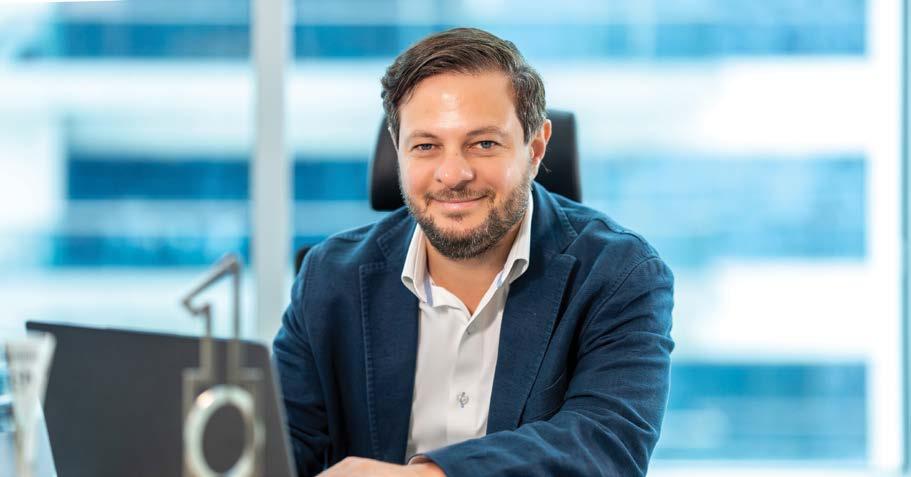
KEYPER, a UAE-based rent-now-pay-later (RNPL) platform, has raised US$4 million in a pre-Series A equity round led by BECO Capital, a UAE-headquartered early-stage venture capital (VC) firm, and Middle East Venture Partners (MEVP), a Middle East-focused VC firm that invests in early and growth stage tech startups. The round, which was announced in May, also saw the participation of some of Keyper’s existing investors such as Vivium Holding, Jabbar Group, Signature Developers, as well as new investors including Annex Investments, Pin Investment, and Al Qahtani Investment.
In addition to the pre-Series A equity capital raise, Keyper has also signed a term sheet agreement for an additional US$30 million in Shari’ah-compliant sukuk financing from Franklin Templeton Middle East, a UAE-based global asset manager that is regulated by the Dubai Financial Services Authority. With both sets of financing, the proptech startup’s accumulated capital has now reached over US$40 million. With this influx of funds, Keyper co-founder and CEO Omar Abu Innab explains that his platform is set to further digitize
Keyper CEO Omar Abu Innab’s tips for entrepreneurs
} FIND A SPECIFIC PROBLEM
“Always look for a problem you are solving for consumers or businesses, and have a key total addressable market."
} BUILD A NETWORK "Speak to as many investors (individuals and VCs) as possible. Continue building relationships and maintaining dialogue for future rounds and partnerships."
} CREATE A ROADMAP "Focus on showing proof of early traction (successful case studies), path to profitability, and healthy marginsgrowing revenues is no longer enough!"
the UAE’s rental ecosystem, while also allocating an amount towards innovating its RNPL solution.
“At Keyper, our rental experience is already digital-first, from digitally onboarding owner property portfolios, triggering, and activating a listing of a unit, to booking a viewing, to signing and most importantly, paying for your rent” Abu Innab says. “Moreover, artificial intelligence (AI)-driven automations are already empowering our team to handle more leads in less time than the market standard. Additionally, it is also giving the landlord full visibility during the leasing journey. In the coming weeks and months, we will thus be launching more digital solutions not only aimed at improving the experience of property search, but also post offers. For example, a feature we are excited about is the first fully digital tenant screening tool in Dubai. This will bring Keyper tenants at par with the standards in top real estate markets like New York and London, ensuring that every tenant placed by Keyper is fully vetted in a fair and transparent manner.”
But according to Abu Innab, apart from introducing more
digitally accessible amenities within the UAE real estate sector, there is one particularly dire need within the market that needs to be addressed: rental cash flow solutions in the UAE market. And according to the co-founder, his startup’s sukuk financing could hold the key to negating this bottleneck.
“Keyper’s sukuk financing enables landlords to access their future rental cash flow at any point during the lease and across their entire portfolio, allowing them to buy a new unit, or pay for an unexpected expense,” Abu Innab explains. “For tenants, it offers monthly rent payments that address the growing pain points of ongoing rental costs. This alleviates the need to pay up to 12 months of rent in advance, allowing them to manage their expenses. The effects will thus be two-fold. It will introduce UAE landlords to a more financial perspective of their real estate investments, triggering an expectation that other ecosystem players provide them with the same level of data and access to financial solutions. For tenants, it will create an expectation that monthly digital payments are available for all units. Our hope is to collaborate with other ecosystem players to enable digital rental payments and cashflow solutions for their clients. Abu Innab also notes that Keyper’s $30 million sukuk financing also holds additional gravitas owing to the amount raised. “This financing will be the largest Shariah-compliant financing raised by an early-stage startup in the Middle East, which will benefit landlords and tenants that have been limited by the lack of Islamic financing options available in the real estate market,” he says.
So far, Keyper’s operational model to serve the nation’s real estate market seems to have held the proptech startup in excellent
→ KEYPER is a UAE-based rent-nowpay-later (RNPL) platform.
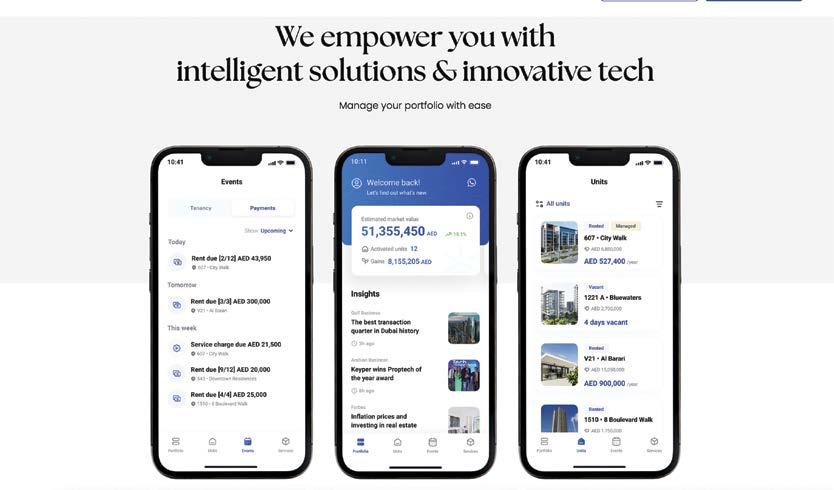
stead. In 2024 alone, the platform onboarded more than 3,000 residential units worth $2 billion, thereby processing over $10 million in annual rent payments and deploying over $1 million in annual rent facilitation through its RNPL product. And the secret to unlocking such milestones, Abu Innab says, lies in the Keyper team’s ability to recognize the trends that dictate the sector’s performance.
“We have seen a growing sophistication among UAE landlords- they want data and financial offerings contextual to their real estate investments, the same way that they do with their stocks,” he says. “To do this, there must be the integration of technology, data, finance and real estate expertise. Keyper is the only player in the UAE market (and one of the few globally) that combines these four key elements. Landlords have been eagerly waiting for a solution like ours, which explains our growth in property accounts, in spite of our limited marketing to date.” Abu Innab also points out that keeping a keen eye out for shifts in the ecosystem is not just reserved for the property owners. “On the consumer side, there is a growing concern around affordability of
rent,” Abu Innab reveals. “A growing population that is not being matched by the increase in rental supply, which is significantly composed of young professionals, is struggling to make sense of how and why to pay 12 months in advance. They either don’t have the funds or struggle to justify the opportunity cost of putting up that much money in advance, instead of investing it or keeping it for their emergency fund. That, coupled with their growing expectation of digital payment solutions, has made RNPL a no-brainer for them.”
With the above trends in mind, and the whopping $34 million freshly injected into the startup’s operations, Abu Innab will now hope to continue Keyper’s mission to keep digitally transforming the UAE’s real estate market. “Our goal is that the rental journey in the UAE becomes digital-first!” he declares. “For that, you will, of course, need agents and in-person viewings, but many of the components of the journey that today lead to unsatisfactory experiences will be disrupted and digitized. This will not only make the journey smoother for all involved parties, but also bring fairness and transparency to the rental processes.”
MYSAFE, A UAE-BASED PROVIDER OF AUTOMATED SAFE DEPOSIT BOX CENTERS, announced in June that it has secured US$4 million in a Series A funding round, which the company aims to use to accelerate its growth trajectory, while also advancing its mission of revolutionizing the security landscape with cutting-edge solutions.
Founded in 2016, Mysafe calls itself a pioneer in fully automated safe deposit box centers, and it currently has a presence in the UAE, Kenya, and the United States. Its state-of-the-art facilities provide top-notch security and convenience, featuring advanced biometric scans for access, and given that they are open 24/7/365, Mysafe ensures that one’s valuables are accessible at any time.
Its Series A round was led by Evanox, a venture capital firm known for its strategic investments in high-growth technology companies, and it marks a significant milestone for Mysafe as it looks to expand its network and to bolster its presence in the market.
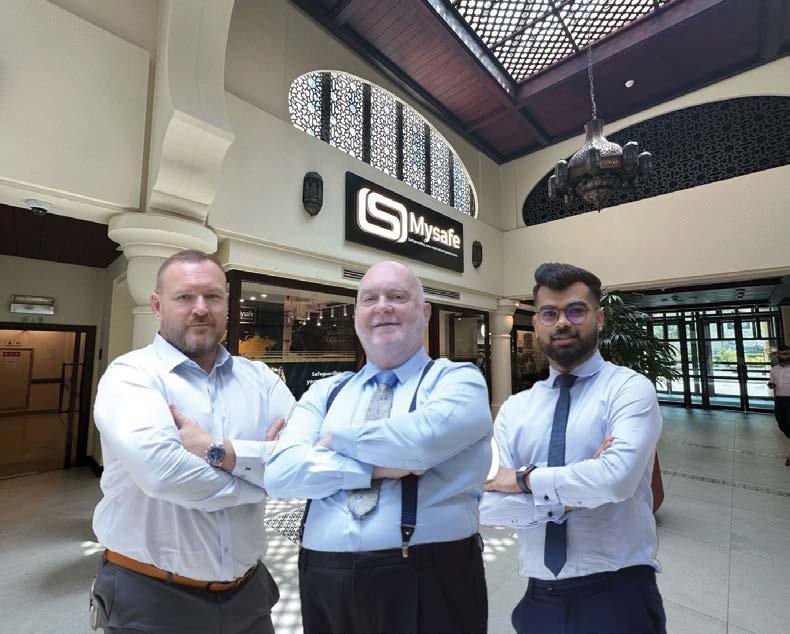
“We are thrilled to have secured $4 million in funding through our Series A round,” said Terence Downes, CEO of Mysafe, in a statement. “This investment underscores the confidence that investors have in Mysafe’s vision, and the value we bring to the market. With this capital infusion, we are well-positioned to expand our footprint, and deliver unparalleled security solutions to a broader range of customers.”
Sascha Winter, Deputy CEO of Mysafe, added, “The successful completion of our Series A financing is a testament to the dedication and hard work of the entire Mysafe team. We are excited about the opportunities that lie ahead. This funding will enable us to further enhance our product offerings, and scale our operations to meet the evolving needs of our customers.”
Commenting on the fundraising process for Mysafe, Winter told Entrepreneur Middle East that it all began thanks to investors coming upon their offerings and being awed by them. “We were thrilled when clients who had rented several boxes at our Al Manzil Souq branch in Dubai approached us, highly impressed by our technology,” Winter revealed. “Their enthusi-
asm led to a meeting in September last year, where we discussed potential expansion opportunities. Shortly after, we signed a memorandum of understanding and a non-disclosure agreement, marking the beginning of a thorough due diligence process that spanned several months. By May, we had reached a definitive conclusion.”
Mysafe’s Series A round comes at a time when a surge has been noted in investments in the MENA; however, Winter notes that such a situation also means that the region’s entrepreneurs are competing with each other to secure funds for themselves. “Navigating this competitive environment is indeed challenging, with numerous entrepreneurs presenting innovative ideas, and a plethora of investors eager to support them,” Winter noted. “Finding the perfect match requires persistence and perseverance. Conducting diligent research, leveraging your network, and maintaining visibility both online and offline are crucial steps. Don’t hesitate to step back if the chemistry isn’t right; it’s essential to ensure a harmonious partnership for future success.”








































More of us need to embrace the role of the workplace “villain”
There was a time when I would have been horrified to know that someone thought of me as the proverbial “bad guy” at work. Nowadays, however, I tend to see it as a badge of honor.
Now, before any of you start visualizing me as a beast from your favorite childhood fantasy, I suppose it’s important to clarify that the “bad guy” I am likening myself to here falls into the category of the good kind of villains in the workplace.
Being the “bad guy” here isn’t about being unkind or untoward. Instead, it’s about having the courage to make tough decisions that won’t be liked by everyone around you. It’s about
speaking up even when the rest of the world is seemingly content to keep mum. It’s about calling out anyone—and I mean anyone— and holding them accountable for their actions.
This includes, for example, the managers who would call out their most trusted subordinates when they commit a mistake. Or, say, the employees who decide to be the voice of dissent when the leadership announces a move that is almost certain to be a misstep. Sometimes, it’s the colleagues who insist on quality and following standards, even if it means slowing down or reworking a project.
In an era where many among us are driven by an











